2009 Aston Martin V8 Vantage
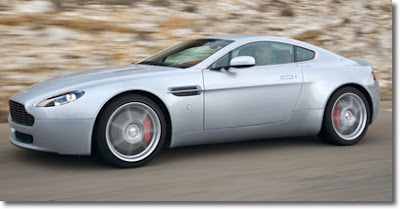
While the universally distinctive and award-winning shapeof the V8 Vantage is retained, the car benefits from a number of technical changes which include significantly up-rated engine performance from a new 4.7 litre power unit in both Coupe and Roadster variants. Other changes include revised dynamics to take full advantage of increased power and torque availability, improved Sportshift™ transmission software and a new sports suspension option.
The 4.7 litre V8 engine has a power output of 420bhp (an 11% increase on the previous 4.3 litre unit) and delivers peak torque of 470Nm (15% increase), providing the V8 Vantage with new reserves of mid-range performance, an improved 0-60mph time of 4.7 seconds and top speed of 180mph (288kph). Combined European fuel economy and CO2 emissions are also improved by 13% (Sportshift™).
Inside, the changes include a new centre console and revised switchgear and the introduction of an ECU replacing the previous V8 Vantage key. Externally, the acclaimed V8 Vantage design appearance is enhanced with a range of new standard and optional 19'' alloy wheels.

Improvements in performance have been achieved through a number of carefully developed changes to Aston Martin's acclaimed V8 engine.
The new forged steel crankshaft provides the 91mm stroke and incorporates new holes in the counter weights for reduced rotating mass and improved inter-bay breathing. New forged steel con-rods and cast aluminum pistons complete the capacity-related changes.
Other key changes include efficiency improvements to the dry sump lubrication system, including a new sump casting with oil pick-up points moved from the front and rear to the sides of the sump. The cylinder heads are modified with a new intake port and an inlet valve size increase from 34.9mm to 35.9mm. The intake manifold has been modified to match the new port to optimise air flow.

Transmission
The V8 Vantage transmissions have also undergone changes to improve performance and to handle the increased levels of power and torque. Both the standard manual stick-shift gearbox and the optional Sportshift™ transmission benefit from a modified clutch and flywheel, reducing clutch pedal efforts and delivering a 0.5kg weight saving, reducing the rotating masses within the powertrain, and hence increasing engine responsiveness.
Aston Martin's Sportshift™ transmission has undergone a series of specific changes to broaden the capabilities of the gearbox to offer customers enhanced comfort and convenience with sporting capabilities. Changes include a revised control strategy, allowing the transmission, rather than the engine, to dictate how best the engine torque should be deployed to optimise performance and deliver power smoothly and consistently.
Sportshift™ now also has the capability to take inputs from the steering wheel enabling the current gear to be held when the car is negotiating a corner and hill descent detection, allowing a low gear to be held, maximising the effects of engine braking.

Suspension
A series of improvements are introduced to the V8 Vantage chassis and suspension setup to deliver improved body control and low speed ride quality; enabling the driver to take full advantage of the increased performance potential. A number of the improved components originally introduced on the Vantage Roadster are now carried over to the Coupe, including revised upper damper mountings and bump stops. Additionally, the front spring rates are stiffened by 11% at the front and 5% at the rear.
Steering geometry is also modified to improve steering feel, while the front lower suspension arm compliance bushes are stiffened by 22% to provide enhanced steering response and handling.

Design & Optional Equipment
Also introduced as an option for both Coupe and Roadster variants is a new Sports Pack which comprises forged lightweight alloy wheels aiding a lower unsprung mass, re-tuned Bilstein dampers with improved dynamic response, up-rated springs and a revised rear anti-roll bar (Coupe only). The Sports Pack is intended to offer greater agility, high speed body control and precision feel for the most enthusiastic of drivers.
Source: RSportscar
2009 Acura TL SH-AWD
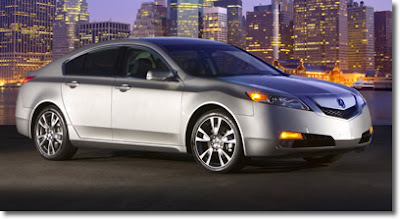
Since inception, the Acura TL performance luxury sedan has set lofty standards for styling, performance, comfort and technology. Available for 2009 in two distinctly different models, TL and TL SH-AWD®, the all-new fourth-generation Acura TL dramatically expands the model's capabilities and appeal with evocative style, a choice of two VTEC® powertrains (including a new 305-horsepower V-6) and the TL's first-ever application of Super Handling All-Wheel Drive™ (SH-AWD®).
Boasting larger dimensions, optimized suspension, a new Sequential SportShift transmission, plus an available Technology Package featuring a comprehensive array of navigation and communication aids, the 2009 TL offers more appeal than ever before. Along with an available Acura/ELS Surround® premium 10-speaker surround sound system and an all-new AcuraLink® weather feature, the new TL is by far the most technologically advanced sedan in Acura's history.
The combination of dramatic new styling, exhilarating performance and an extensive array of electronics (including AcuraLink® real-time traffic and AcuraLink® weather with Doppler-style radar mapping) ensures the 2009 Acura TL will appeal to a sophisticated, technology-savvy audience.
Powertrain
A choice of two different all-aluminum VTEC® engines enables the new 2009 TL to satisfy a wide range of customers. Standard is a 3.5-liter V-6 producing 280 horsepower and 254 lb-ft of torque that sends power to the front wheels through Acura's sophisticated Sequential SportShift 5-speed automatic transmission with steering-wheel- mounted paddle shifters and Grade Logic Control. Though powerful, the new engine is also fuel efficient, with projected EPA fuel economy ratings* of 18 mpg city and 26 mpg highway. The engine is targeted to meet
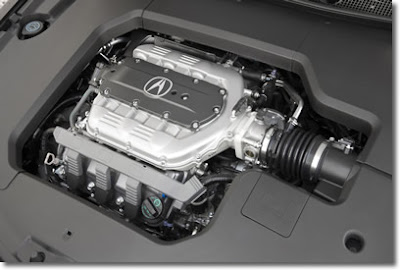 Serious performance-sedan devotees will choose the TL SH-AWD® to make winding roads their own. Its all-new 3.7-liter V-6 engine produces 305 horsepower and 273 lb-ft of torque courtesy of greater displacement and additional high-performance features like Variable Valve Timing and Lift Electronic Control (VTEC®) on both the intake and exhaust valves, and a special high-flow dual exhaust system. With projected EPA fuel economy ratings* of 17 mpg city and 25 mpg highway, the 3.7L is also targeted to meet California's stringent CARB LEV II ULEV emissions certification. The pièce de résistance on the TL SH-AWD® is the Super Handling All-Wheel Drive™ system, now available on the TL for the first time.
Serious performance-sedan devotees will choose the TL SH-AWD® to make winding roads their own. Its all-new 3.7-liter V-6 engine produces 305 horsepower and 273 lb-ft of torque courtesy of greater displacement and additional high-performance features like Variable Valve Timing and Lift Electronic Control (VTEC®) on both the intake and exhaust valves, and a special high-flow dual exhaust system. With projected EPA fuel economy ratings* of 17 mpg city and 25 mpg highway, the 3.7L is also targeted to meet California's stringent CARB LEV II ULEV emissions certification. The pièce de résistance on the TL SH-AWD® is the Super Handling All-Wheel Drive™ system, now available on the TL for the first time.
During spirited cornering, SH-AWD® seamlessly distributes more torque to the outside rear wheel to create a "yaw moment" to help the TL turn in more quickly and precisely - while also continuously apportioning drivetrain torque front to rear and left to right. The result is a remarkably balanced and precise all-wheel-drive performance sedan that excels year-round, not just during inclement weather.
Acura TL's performance achievements extend to durability, reliability and refinement as well. Both engines feature electronically controlled engine mounts to reduce engine noise, vibration and harshness (NVH); quiet and efficient Electric Power Steering (EPS) and maintenance-free serpentine accessory belt also boost operating refinement. A standard Maintenance Minder™ system and up to a 100,000-mile tune-up interval offer further time and cost savings for the TL owner.
The standard transmission on the 2009 TL and TL SH-AWD® is a Sequential SportShift 5-speed automatic featuring F1®-style steering-wheel mounted paddle shifters and Grade Logic Control. Merging the convenience of an automatic with the enjoyment of SportShift manual gear selection, the transmission also features an overdriven top gear for maximum fuel efficiency on the highway. In fact, the Acura transmission has the widest gear-ratio spread of any 5-speed transmission in its class, providing strong acceleration in lower gears and relaxed, fuel-efficient highway cruising.

Body/Chassis
Major improvements in structural engineering for the unit-body further define the 2009 TL. The list of substantial changes begins with the relocation of frame rails inside (rather than underneath) the vehicle's floor pan, resulting in a nearly flat body underside. Benefits of this design include improved crash safety, a significant reduction in interior noise levels, and reduced aerodynamic drag that helps enhance fuel economy. Another significant improvement is the increased use of high-strength steel, which simultaneously improves the unit-body's overall strength while helping to reduce weight. For additional weight savings, aluminum is used for the hood, the front suspension subframe and rear suspension knuckles.
Ride quality and passenger comfort benefit from the 2009 TL's larger exterior dimensions. Featuring 6.0 inches greater exterior length, 1.8 inches more overall width and a modest 0.5-inch increase in overall height, the TL is noticeably larger than its predecessor.
The larger body size directly contributes to greater interior roominess; it also allows a 1.4-inch longer wheelbase to improve ride quality and a significantly wider track (1.1 inches wider in front, 1.8 inches wider in the rear) helps generate even more tenacious cornering power. The TL employs a double-wishbone independent front suspension and a multi-link independent system in back.
Further improving ride quality and road-holding are new dual-stage "blow off" style hydraulic suspension dampers, new hydro-compliant bushings (used to mount the transmission and key suspension components) and a new "smart" engine mount design. On the Super Handling All-Wheel Drive™ (SH-AWD®) model, more performance-minded suspension and brake tuning, larger wheels/tires, racing-inspired front brake cooling ducts, and specially-tuned Electric Power Steering (EPS) take the enthusiast's driving experience to an even higher level.
Exterior/Interior
An evocative and powerful exterior body design dramatically advances the TL's image as a performance luxury sedan. Designed by Acura in
Wheels and tires are as expressive as the exterior styling. Standard on the 2009 TL are 17-inch aluminum wheels with P245/50R17 all-season Bridgestone Turanza or available Michelin Pilot tires for confident year-round performance. The TL SH-AWD® comes with 18-inch aluminum wheels with lower-profile P245/45R18 Michelin Pilot tires for more agile handling. Finally, the TL SH-AWD® offers available 19-inch aluminum wheels with aggressive P245/40ZR19 Michelin Pilot Sport PS2 summer tires for the ultimate TL performance experience.
 In keeping with its mission as a driver's car, the 2009 TL interior features a new "dual personal" layout that provides both the driver and front passenger with their own personal space. Thanks to its larger exterior dimensions, the new TL has 1.3 inches more rear legroom and 0.5-inch of added rear shoulder room compared to the previous generation TL.
In keeping with its mission as a driver's car, the 2009 TL interior features a new "dual personal" layout that provides both the driver and front passenger with their own personal space. Thanks to its larger exterior dimensions, the new TL has 1.3 inches more rear legroom and 0.5-inch of added rear shoulder room compared to the previous generation TL.
 Acura's commitment to luxury and technology becomes apparent from the first moment the driver's door is opened. With sweeping shapes, generous use of premium materials and passionate attention to detail, the TL rewards the discriminating eye. The design and execution of the interior is an artful combination of leather surfaces, accented by metallic and wood-pattern trim. An impressive array of premium standard features includes a power moonroof, dual-zone adaptive climate control, 10-way adjustable (8-way power seat with 2-way power lumbar support) driver seat, 8-way adjustable power front passenger seat, and steering-wheel-mounted F1®-style paddle shifters for the Sequential SportShift automatic transmission. An 8-speaker, 276-watt audio system that includes a 6-disc CD changer, AM/FM radio, XM® Satellite Radio, Bluetooth® Audio, USB port and AUX jack connectivity, and HandsFreeLink® wireless telephone interface are standard.
Acura's commitment to luxury and technology becomes apparent from the first moment the driver's door is opened. With sweeping shapes, generous use of premium materials and passionate attention to detail, the TL rewards the discriminating eye. The design and execution of the interior is an artful combination of leather surfaces, accented by metallic and wood-pattern trim. An impressive array of premium standard features includes a power moonroof, dual-zone adaptive climate control, 10-way adjustable (8-way power seat with 2-way power lumbar support) driver seat, 8-way adjustable power front passenger seat, and steering-wheel-mounted F1®-style paddle shifters for the Sequential SportShift automatic transmission. An 8-speaker, 276-watt audio system that includes a 6-disc CD changer, AM/FM radio, XM® Satellite Radio, Bluetooth® Audio, USB port and AUX jack connectivity, and HandsFreeLink® wireless telephone interface are standard.
Available on both the TL and TL SH-AWD® is a Technology Package that includes the most comprehensive array of advanced electronic features ever offered by Acura. The Technology Package includes the Acura Navigation System with Voice Recognition™, AcuraLink® real-time traffic, AcuraLink® weather with Doppler-style radar mapping, an Acura/ELS Surround® premium audio system and Keyless Access System with pushbutton ignition. The included Navigation System features a new 8-inch full VGA high-resolution color display for improved visibility.
Audiophiles with appreciate the new Acura/ELS Surround® 10-speaker, 440-watt premium sound system with DVD-Audio, CD, DTS™, AM/FM radio, XM® Satellite Radio and 2,500-song** hard disk drive (HDD) media storage. An intuitive interface dial as well as sophisticated voice recognition capability simplifies control of this impressive technology. Premium Milano leather seating surfaces included in the Technology Package further enhances comfort and visual appeal.
Safety
Advanced Compatibility Engineering™ (ACE™) represents a major advance in structural engineering for the 2009 TL. In simple terms, ACE™ better dissipates crash energy in a severe frontal collision through the use of dedicated load-bearing frame structures that efficiently distribute crash energy through the body structure-while also helping to preserve the integrity of the passenger compartment. Acura first introduced ACE™ to the Acura line for the 2005 model year and its inclusion in the 2009 TL means that every vehicle in the Acura model range now has this advanced safety engineering.
Six airbags and a new active head restraint system for the driver and front passenger headrests top the long list of passive safety features built into the new TL. The airbag array includes dual-stage, dual-threshold front airbags, new dual-chamber front seat side airbags with front passenger seat Occupant Position Detection System, along with side-curtain airbags for all outboard seating positions. Additional passive-safety features include 3-point seatbelts and head restraints for all seating positions, driver and front passenger seatbelt load-limiters with an automatic tensioning system and a Lower Anchors and Tethers for CHildren (LATCH) system that permits quick, secure attachment of up to two child seats in the rear seating area.
The new TL includes sophisticated active safety features including powerful 4-wheel disc brakes (with ABS, EBD and Brake Assist), Vehicle Stability Assist (VSA), Tire Pressure Monitoring System (TPMS), all-season tires and an available SH-AWD® system. Adding to the list of standard exterior safety features are daytime running lights (DRL) along with 2.5-mph front and rear bumpers.
The 2009 Acura TL is designed to meet the latest crash-safety regulations, including the new FMVSS214 side crash standards (which the TL meets three years early) and the new FMVSS301 rear crash standards. Internal testing indicates that the 2009 TL should achieve the highest ratings in National Highway Traffic Safety Administration (NHTSA)*** and Insurance Institute for Highway Safety (IIHS) crash tests.
The 2009 Acura TL is assembled in

Acura
Acura offers a full line of technologically advanced performance luxury vehicles through a network of 270 dealers within the
For more information about Acura vehicles, please visit www.acura.com. For media inquiries, please go to www.acuranews.com.
* Based on preliminary 2009 EPA mileage estimates determined during internal testing that reflects new EPA fuel economy methods beginning with 2008 models. Use for comparison purposes only. Do not compare to models before 2008. Your actual mileage will vary depending on how you drive and maintain your vehicle. **Approximate music storage capacity *** Government star ratings are part of the National Highway Traffic Safety Administration's (NHTSA's) New Car Assessment Program (www.safercar.gov). Model tested with standard side-impact air bags (SABs).
Official Honda Motor Company Press Release
2009 Peugeot 908HY
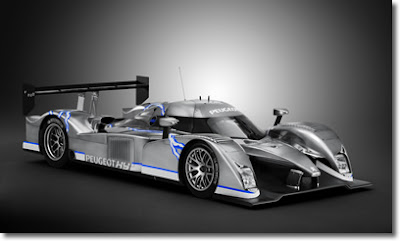
The Peugeot 908 HDi FAP Hybrid Le Mans-series race car, competing in the top LMP1 class consisting of the fastest cars to enter the storied endurance road racing series, showcases an exciting hybrid racing powertrain that could once again revolutionize the way
 Key to the hybrid technology used in the new Peugeot 908 is a small regenerative hybrid motor and 10 battery packs, stored within the cabin and under the floor, allowing the Peugeot 908 to either run using consistently less fuel or go into push-button "boost" mode, allowing the driver up to 20 seconds per lap with an extra 80 electric motor-powered horsepower on tap for passing maneuvers.
Key to the hybrid technology used in the new Peugeot 908 is a small regenerative hybrid motor and 10 battery packs, stored within the cabin and under the floor, allowing the Peugeot 908 to either run using consistently less fuel or go into push-button "boost" mode, allowing the driver up to 20 seconds per lap with an extra 80 electric motor-powered horsepower on tap for passing maneuvers.
Like a Toyota Prius and other boring full-hybrid passenger cars, kinetic energy created during braking is pumped through the powertrain and stored within the batteries. Much different, though, is the Peugeot 908's ability to dump all this energy at once, producing a huge boost in horsepower. Is this a new hybrid technology that will soon make its way to road-going sports cars? We can only dream...
 The Peugeot Sport 908 HDi FAP LMP1 car is relatively untested, having made its debut right at the end of the 2008 Le Mans-class racing season. Peugeot cars did well this season, though, being the first automaker in several years to give a significant challenge to Audi TDI cars in the top LMP1 class.
The Peugeot Sport 908 HDi FAP LMP1 car is relatively untested, having made its debut right at the end of the 2008 Le Mans-class racing season. Peugeot cars did well this season, though, being the first automaker in several years to give a significant challenge to Audi TDI cars in the top LMP1 class.
Like the Audi R10 cars, the 908 hybrid uses a V12 diesel motor. A successful 2008 racing season proves Audi is not the only automaker to make diesel cars successful in endurance racing.

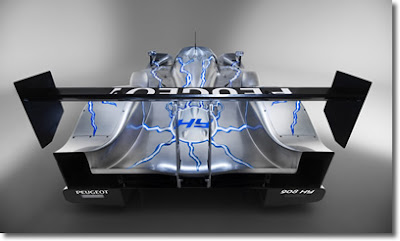 Peugeot Sport officials have expressed some doubt as to whether the 908 with hybrid technology will be allowed to race in next year's LMP1 class, though for the advancement of the technology and plain old good racing, ALMS and Le Mans racing officials would do well to allow it.
Peugeot Sport officials have expressed some doubt as to whether the 908 with hybrid technology will be allowed to race in next year's LMP1 class, though for the advancement of the technology and plain old good racing, ALMS and Le Mans racing officials would do well to allow it.
Source: RSportscars
2008 Volvo C30
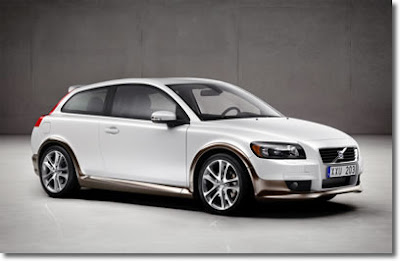
In conjunction with Volvo Cars unveiling of the all-new C30 at 2006 Paris Motor Show, Volvo Cars of North America announced that it will bring the car to the
Pricing and volume expectations for the U.S.-bound C30 have not yet been set.
The edgy design of the C30 features a unique frameless glass tailgate, a confident stance and the broad shoulders that have become a Volvo design hallmark. "The C30 has plenty of muscles in a sporty and compact package," noted Volvo Car's Design Director Steve Mattin. "Anyone who recalls the Volvo SCC (Safety Concept Car) or the classic P1800ES will recognize the exclusive and convenient rear tailgate. The distinctive tail lamps ensure that no one will be uncertain about which car they are following."
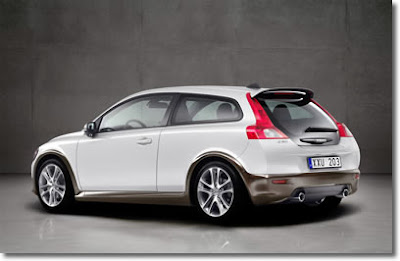 Putting 218 horsepower to the front wheels, the new C30 is powered by a turbocharged inline five-cylinder engine that produces 236 pound-feet of torque.
Putting 218 horsepower to the front wheels, the new C30 is powered by a turbocharged inline five-cylinder engine that produces 236 pound-feet of torque.
Measuring in at just 167 inches in length, the C30 is the smallest member of Volvo's model range -- an impressive 8.5 inches shorter than the Volvo S40 sport sedan while still retaining the 103.9 inch wheel base, which really pushes the wheels towards the end of the car. "A car that exudes muscular maneuverability must live up to the promise of its looks when you are behind the wheel," said C30 project leader Hakan Abrahamsson. "Therefore, the C30 has a chassis that offers sporty driving characteristics, nimble handling and responsive steering."
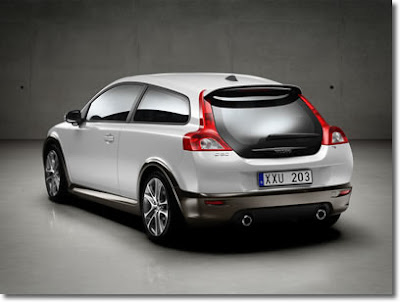 Right out of the box, audio enthusiasts will appreciate the Volvo C30's standard 160-watt stereo system. And true audiophiles can choose a Premium Sound system that closely matches the acclaimed system offered in the new C70, with a digital 5x130W ICE Power amplifier from Alpine, Dolby Pro Logic II Surround, and 10 loudspeakers from Danish loudspeaker manufacturer Dynaudio. Total output for the Premium Sound System is an astonishing 650 watts. Simply put, it rocks.
Right out of the box, audio enthusiasts will appreciate the Volvo C30's standard 160-watt stereo system. And true audiophiles can choose a Premium Sound system that closely matches the acclaimed system offered in the new C70, with a digital 5x130W ICE Power amplifier from Alpine, Dolby Pro Logic II Surround, and 10 loudspeakers from Danish loudspeaker manufacturer Dynaudio. Total output for the Premium Sound System is an astonishing 650 watts. Simply put, it rocks.
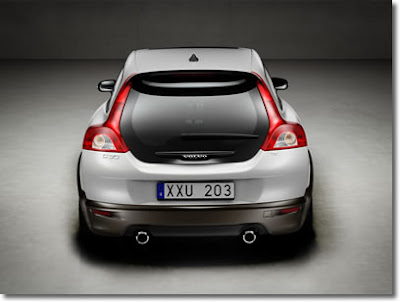 When it comes to safety, the new C30 is a true Volvo. Among other things, it will be available with BLIS (Blind Spot Information System), which helps the driver to identify another vehicle in the blind spot at the rear sides of the car.
When it comes to safety, the new C30 is a true Volvo. Among other things, it will be available with BLIS (Blind Spot Information System), which helps the driver to identify another vehicle in the blind spot at the rear sides of the car.
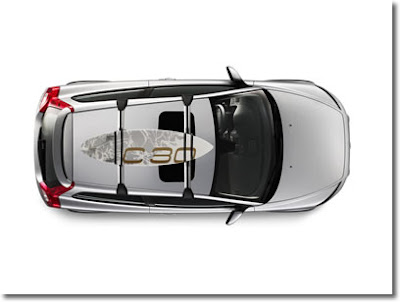
The front end incorporates the same patented multi-steel structure as the S40 and V50. Combined with airbags and safety belt pretensioners, the C30 offers first class safety. But the C30 wouldn't be a Volvo if it didn't also include such standard safety equipment as the Whiplash Protection System, WHIPS, and a Side Impact Protection System with side airbags and the Inflatable Curtain, IC.
| Specifications | |||||||||||||||||||||||||||||||||||
| | ||||||||||||||||||||||||||||||||||
Source: RSportscars
2008 Volkswagen Scirocco GT24
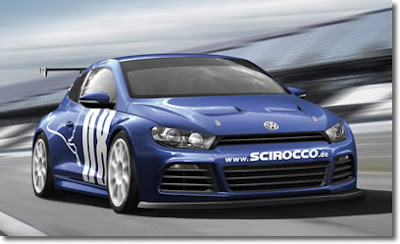
Volkswagen is presenting the racing version of the Scirocco GT24 at
 Yet the race car remains unmistakeably a Scirocco from every angle. Just even wider, even longer and even lower," says Volkswagen Chairman for Development Dr Ulrich Hackenberg, who will not be passing up the opportunity to sit behind the wheel in the race in the Eiffel. The 325 PS Scirocco will also be driven during the race by legendary drivers like rally world champion Carlos Sainz and Hans-Joachim Stuck, three-time winner of the 24-hour Nürburgring race.
Yet the race car remains unmistakeably a Scirocco from every angle. Just even wider, even longer and even lower," says Volkswagen Chairman for Development Dr Ulrich Hackenberg, who will not be passing up the opportunity to sit behind the wheel in the race in the Eiffel. The 325 PS Scirocco will also be driven during the race by legendary drivers like rally world champion Carlos Sainz and Hans-Joachim Stuck, three-time winner of the 24-hour Nürburgring race.
 Incidentally, "Striezel" Stuck won the very first 24-hour race at the Nürburgring in 1970. Now, thirty-eight years later, the Scirocco GT24 is competing. It draws its power from only two litres displacement: the 16-valve direct injection engine with a turbocharger and intercooler delivers its maximum torque of 340
Incidentally, "Striezel" Stuck won the very first 24-hour race at the Nürburgring in 1970. Now, thirty-eight years later, the Scirocco GT24 is competing. It draws its power from only two litres displacement: the 16-valve direct injection engine with a turbocharger and intercooler delivers its maximum torque of 340
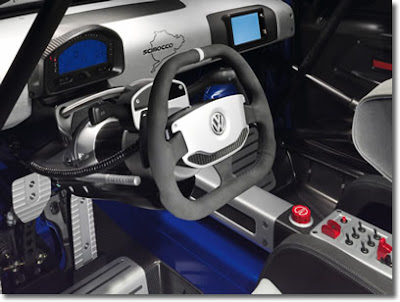
 The idea of an affordable dream car was born in the 70s with the first Scirocco. The success of this two-seat sport coupe continued for nearly 20 years, during which time more than 360,000 Sciroccos were built. The enthusiasm for this car has been uninterrupted since Volkswagen presented the new version of the Scirocco at this year's Geneva Motor Show. The new car appears to have struck a chord with car buyers and will pick up with the success of the original Scirocco which, in the mean time, has developed into a cult car.
The idea of an affordable dream car was born in the 70s with the first Scirocco. The success of this two-seat sport coupe continued for nearly 20 years, during which time more than 360,000 Sciroccos were built. The enthusiasm for this car has been uninterrupted since Volkswagen presented the new version of the Scirocco at this year's Geneva Motor Show. The new car appears to have struck a chord with car buyers and will pick up with the success of the original Scirocco which, in the mean time, has developed into a cult car.
Official Volkswagen Press Release
2008 Ferrari FXX Evolution
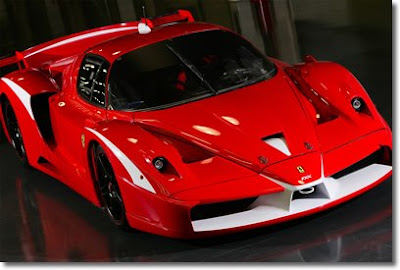
Courtesy of Ferrari
The innovative FXX program, based on the eponymous prototype car and launched by Ferrari in June 2005, is being extended to 2008/2009. The FXX, which is the most advanced GT ever created at Maranello, has been updated with an evolution package aimed at further improving its handling and performance. The package was developed as a result of Ferrari's collaboration with its Client Test Drivers and with the invaluable support of Michael Schumacher. The FXXs equipped with this package will also sport a new livery in addition to new rear wing profiles.
 The FXX is not homologated for road use and there are no plans to compete with it either. In fact, the FXX prototype is designed exclusively for track driving as part of a specific R&D program agreed with a selected group of just over 20 clients involving 14 group test sessions and 14 private ones in the last two years. Thanks to readings taken over the 10,200 miles of tests carried out in 2006 and the 11,500 miles covered in 2007, the modifications made to the car have focused on honing its aerodynamics, running gear and electronics. Seven-times Formula 1 World Champion Michael Schumacher also joined the ranks of the client test drivers and gave the program the benefit of his vast experience on several occasions.
The FXX is not homologated for road use and there are no plans to compete with it either. In fact, the FXX prototype is designed exclusively for track driving as part of a specific R&D program agreed with a selected group of just over 20 clients involving 14 group test sessions and 14 private ones in the last two years. Thanks to readings taken over the 10,200 miles of tests carried out in 2006 and the 11,500 miles covered in 2007, the modifications made to the car have focused on honing its aerodynamics, running gear and electronics. Seven-times Formula 1 World Champion Michael Schumacher also joined the ranks of the client test drivers and gave the program the benefit of his vast experience on several occasions.
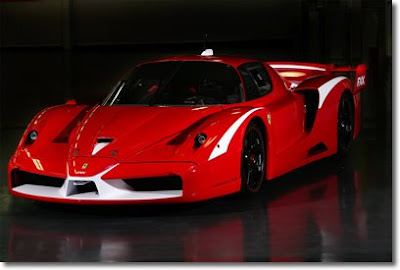 Maranello's engineers studied the wealth of information gained to develop a kit which will cut the FXX's Fiorano lap time to under 1'16'' (previously it was 1'18''). The FXX's 6262 cc V12 engine can now punch out a massive 860 bhp at 9500 rpm. Gearshifting takes just 60 ms, a drop of 20 ms on the previous time, and the gear ratios have been adapted to make use of the extra 1000 rpm now delivered by the engine.
Maranello's engineers studied the wealth of information gained to develop a kit which will cut the FXX's Fiorano lap time to under 1'16'' (previously it was 1'18''). The FXX's 6262 cc V12 engine can now punch out a massive 860 bhp at 9500 rpm. Gearshifting takes just 60 ms, a drop of 20 ms on the previous time, and the gear ratios have been adapted to make use of the extra 1000 rpm now delivered by the engine.
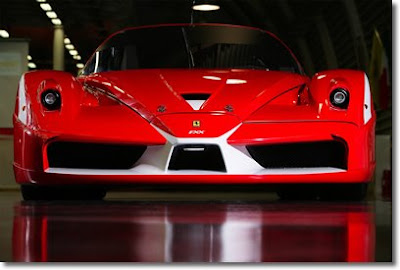 The car's new traction control system, developed in close collaboration with the GES Racing Division engineers, gives the driver a choice of no less than nine different settings (plus the off position) which are selected using a switch on the central tunnel. This means that the driver really can modify the car's behavior on the track from corner to corner, just as the Formula 1 drivers do to maximize performance and reduce tire wear. The FXX's traction control is also now less invasive and more flexible, adapting more efficiently to the individual driving style of each driver - a requirement pinpointed when this very extreme car was being driven on the track by non-professional drivers.
The car's new traction control system, developed in close collaboration with the GES Racing Division engineers, gives the driver a choice of no less than nine different settings (plus the off position) which are selected using a switch on the central tunnel. This means that the driver really can modify the car's behavior on the track from corner to corner, just as the Formula 1 drivers do to maximize performance and reduce tire wear. The FXX's traction control is also now less invasive and more flexible, adapting more efficiently to the individual driving style of each driver - a requirement pinpointed when this very extreme car was being driven on the track by non-professional drivers.
The FXX's special 19" Bridgestone tires now last longer too thanks to a new car setup and new front suspension geometry, while the Brembo brakes, which boast large Composite Ceramic Material (CCM) discs, are more efficient with the result that the brake pads last twice as long. Thanks to the drivers' feedback the Ferrari engineers have also developed new aerodynamic solutions aimed at increasing downforce over the rear axle. The FXX now sports a new rear diffuser, nolder and rear flaps which have combined to increase aerodynamic efficiency by 25% overall. The active front spoiler control system settings have been adjusted to take these modifications into account too. New telemetry monitoring of the steering angle and brake pump pressure will further boost the interaction between Client test drivers and the company's engineers also. From next year onwards, it will be possible for drivers to have two extra video cameras mounted on their car in addition the existing rear-facing one. This will, of course, give the drivers excellent rear visibility without having to impinge in any way on the car's aerodynamics.
The FXX evolution package includes participation in a series of track events that Ferrari is organizing at international circuits for 2008/2009. Six events are planned for each year (two in
As happened in 2006/2007, the cars will be backed up at each event by a 15-member official team made up of engineers, electronics experts and mechanics capable of providing complete assistance to clients. Needless to say, the latter will still be able to organize their own private individual track sessions in their car as well.
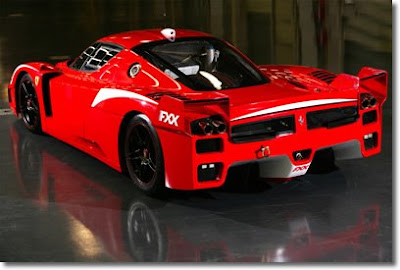
| Specifications | |||||||||||||||||||||||||||||||||||
| | ||||||||||||||||||||||||||||||||||
Source: RSportscars
2008 Vauxhall VXR8
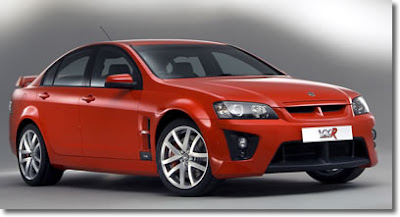
Motoring enthusiasts across
 But the thunder from down under hasn’t stopped yet – in fact it’s only going to get louder. Vauxhall has announced the arrival of a new Aussie musclecar – the VXR8 – and it’s more powerful and exciting than even the legendary Monaro.
But the thunder from down under hasn’t stopped yet – in fact it’s only going to get louder. Vauxhall has announced the arrival of a new Aussie musclecar – the VXR8 – and it’s more powerful and exciting than even the legendary Monaro.
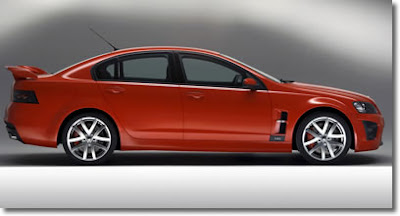 The dramatic-looking new saloon is powered by the same 6.0-liter V8 as the outgoing Monaro VXR, but revisions to the engine have made it even more efficient. It now develops a massive 420 bhp and 406 lb-ft of torque, giving it enough grunt to sprint from 0-60 mph in just 4.9 seconds. No other supercar offers this sort of power for anywhere near the VXR8’s price.
The dramatic-looking new saloon is powered by the same 6.0-liter V8 as the outgoing Monaro VXR, but revisions to the engine have made it even more efficient. It now develops a massive 420 bhp and 406 lb-ft of torque, giving it enough grunt to sprint from 0-60 mph in just 4.9 seconds. No other supercar offers this sort of power for anywhere near the VXR8’s price.
 Yet the VXR8, based on
Yet the VXR8, based on
Although practical, with a spacious boot, comfortable, long-legged cruising ability and luxuries such as climate control and leather trim, the VXR8 is certainly no softie. Driver aids such as the stability system and traction control can be turned off at the flick of a switch – perfect for drivers who want to hone their skills on a track day.
And VXR8 goes as well as it stops, too, with powerful 365mm front disc brakes that slow the car down from 60 mph to a standstill faster than a Lamborghini Murcielago or BMW M5.
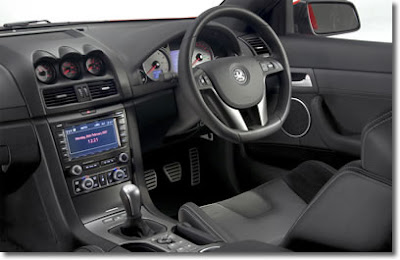 In response to customer demand, the VXR8 will also be the first VXR model to be offered with an automatic gearbox. In order to maintain the control which VXR buyers require, the optional £1,400 self-shifter has a manual override and a sport setting which ensure the performance isn’t blunted – in fact the auto is only half a second slower to 60 mph than the manual.
In response to customer demand, the VXR8 will also be the first VXR model to be offered with an automatic gearbox. In order to maintain the control which VXR buyers require, the optional £1,400 self-shifter has a manual override and a sport setting which ensure the performance isn’t blunted – in fact the auto is only half a second slower to 60 mph than the manual.
Satellite navigation and 20-inch wheels will be offered as options for those who want to make their VXR8 look more distinctive and help find their way to the best driving roads. Even with all the option boxes ticked however, the VXR8 is still around half the price of other cars with comparable performance.
| Specifications | |||||||||||||||||||||||||||||||||||
Base Price: £34,995 | | ||||||||||||||||||||||||||||||||||
Source: RSportscars
2007 TechArt GTsport
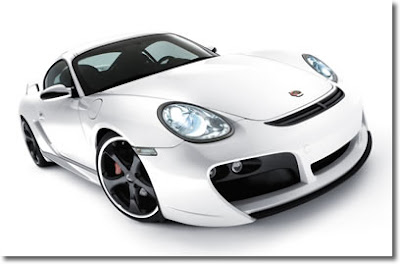
3.8-liter displacement, 385 bhp at 6,600 rpm, a peak torque of 300 lb-ft at 4,600 rpm and a top speed of 177 mph: these are the performance cornerstones of the new TechArt GTsport, a small-series production car based on the Porsche Cayman S. The price starts at $138,000.
At the heart of this mid-engine sports car lies the increase in displacement from standard 3,387 cc to 3,824 cc. The increase is facilitated by a bore enlarged to 99 millimeters with the corresponding larger special pistons, and by the installation of a special crankshaft.
The engine conversion further includes sports camshafts. A modified intake manifold with special air filter system and an aluminum header provide ample combustion air. The perfect interaction of all these components including the fully stainless-steel high-performance exhaust system with high-performance manifold is orchestrated by new mapping for the engine electronics. With a maximum power output of 385 bhp and a peak torque of 300 lb-ft, the engine satisfies both highly sporty minded drivers as well as those GTsport pilots who want lots of pulling power from low engine speed.
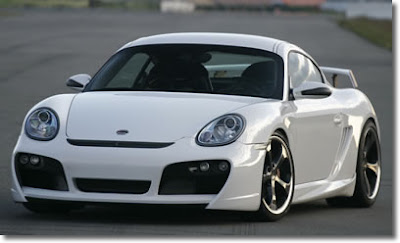 Powered by this engine, the mid-engine sports car offers excellent performance: The sprint from 0 - 62 mph takes just 4.9 seconds, and with a top speed of 177 mph, the TechArt two-seater easily bests its production counterpart in this discipline, too.
Powered by this engine, the mid-engine sports car offers excellent performance: The sprint from 0 - 62 mph takes just 4.9 seconds, and with a top speed of 177 mph, the TechArt two-seater easily bests its production counterpart in this discipline, too.
The exhilarating performance is coupled with striking looks and refined aerodynamic properties. The TechArt GTsport front apron is designed to replace the production bumper. With its large air inlets and four auxiliary headlights it lends the two-seater a more dynamic appearance while reducing lift on the front axle at high speeds. The extendable carbon air splitter can further minimize aerodynamic lift.
The TechArt rocker panels were modeled to calm the airstream between front and rear wheel houses. They also give the two-seater a longer, sleeker appearance. Carbon mirror moldings round out the racing look of the TechArt GTsport.
To optimize downforce on the rear axle and for even more striking looks, TechArt further equips the GTsport with a rear wing with extendable carbon gurney flap. The rear apron is refined by a carbon diffuser.
Striking looks and agile handling are the hallmarks of the TechArt tire/wheel combination on the GTsport. The especially light-weight one-piece TechArt Formula five-spoke wheels are mounted on the front axle in size 8.5Jx20 with tires in size 235/30 ZR20. The rear axle features wheels in size 11Jx20 with 305/25 ZR20 tires.
 Specially calibrated to these wheels and tires is the TechArt VarioPlus coil-over suspension for all vehicles that are factory-equipped with the electronically adjustable PASM damper system. This suspension not only allows adjustable ride-height lowering by up to 1 inch, but also manual selection of damper settings "Normal" and "Sport" at the push of a button in the cockpit. The dampers are not limited by the manually selected setting: Sporty driving automatically firms up the dampers in both suspension modes. The result is an optimal symbiosis of excellent ride comfort during normal driving and agile direct response during fast cornering.
Specially calibrated to these wheels and tires is the TechArt VarioPlus coil-over suspension for all vehicles that are factory-equipped with the electronically adjustable PASM damper system. This suspension not only allows adjustable ride-height lowering by up to 1 inch, but also manual selection of damper settings "Normal" and "Sport" at the push of a button in the cockpit. The dampers are not limited by the manually selected setting: Sporty driving automatically firms up the dampers in both suspension modes. The result is an optimal symbiosis of excellent ride comfort during normal driving and agile direct response during fast cornering.
As a world-renowned specialist for exclusive car interiors, TechArt can customize the interior of the GTsport in the company-own upholstery shop according to customers' individual specifications.
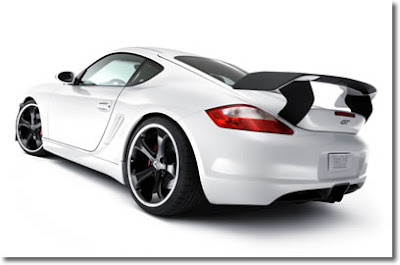 The product lineup includes exclusive fully leather interiors as well a numerous sporty accessories: TechArt offers ergonomically shaped airbag sport steering wheels with three or four spokes as well as aluminum foot pedals, shifter and foot rest. Also available are stainless-steel door sills with TechArt logo.
The product lineup includes exclusive fully leather interiors as well a numerous sporty accessories: TechArt offers ergonomically shaped airbag sport steering wheels with three or four spokes as well as aluminum foot pedals, shifter and foot rest. Also available are stainless-steel door sills with TechArt logo.
| Specifications | |||||||||||||||||||||||||||||||||||
Base Price: $138,000 / 115,000 € | | ||||||||||||||||||||||||||||||||||
Source: RSportscars
2009 Tesla Roadster

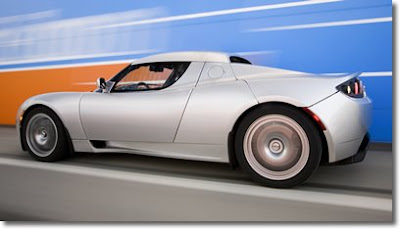 When Tesla Motors began delivering the 2008 Tesla Roadster models at volume levels, the green car world touted the new electric sports car as a major victory, and the car-buying public responded with enormous enthusiasm. The 2008 Tesla Roadster electric car models are completely sold out, even though many have not yet been produced.
When Tesla Motors began delivering the 2008 Tesla Roadster models at volume levels, the green car world touted the new electric sports car as a major victory, and the car-buying public responded with enormous enthusiasm. The 2008 Tesla Roadster electric car models are completely sold out, even though many have not yet been produced.
 Tesla is now taking orders for the 2009 Tesla Roadster electric sports car, and has a new production plant set to open soon in
Tesla is now taking orders for the 2009 Tesla Roadster electric sports car, and has a new production plant set to open soon in
When factoring in the fact that the Tesla Roadster is all electric, meaning an end to dependance on fossil fuels and a cost per mile that is but a fraction of that of the gas guzzler sports cars with similar performance numbers to sports cars costing nearly as much as the small electric wonder, the base price of $109,000 starts to sound like a bargain, if you have that kind of cash.
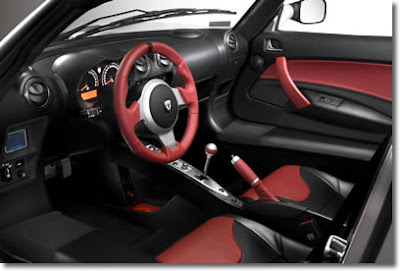 Below is official information released by Tesla on the innovative battery system used by this unique little car. How a small start-up company with capital that is a fraction of that of the automotive industry giants can build an electric car of this performance caliber is something the automotive industry is trying to figure out, and copy, as car buyers clamor for fuel efficient cars without sacrificing performance.
Below is official information released by Tesla on the innovative battery system used by this unique little car. How a small start-up company with capital that is a fraction of that of the automotive industry giants can build an electric car of this performance caliber is something the automotive industry is trying to figure out, and copy, as car buyers clamor for fuel efficient cars without sacrificing performance.

| Specifications | |||||||||||||||||||||||||||||||||||||||||||
| | ||||||||||||||||||||||||||||||||||||||||||
Source: RSportscars
2008 Spyker C12 Zagato
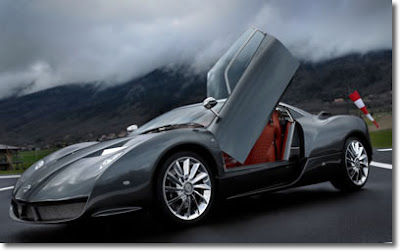
Dutch supercar manufacturer Spyker unveiled the Spyker C12 Zagato at the 77th Geneva International Motor Show. Norihiko Harada, Zagatos Automotive Chief Designer, and Muller co-operated closely to design this limited edition of 24 sports cars to be delivered from March 2008 onwards. The world premiere of this ultra-exclusive version of the C12 range celebrates Spykers entry into the world of Formula One and marks the first integration of design elements and styling cues from the Spyker F8-VII Formula One car into the Spyker road car range. This point was underlined by the unveiling of the car being performed by Spykers Formula One race driver, Adrian Sutil.
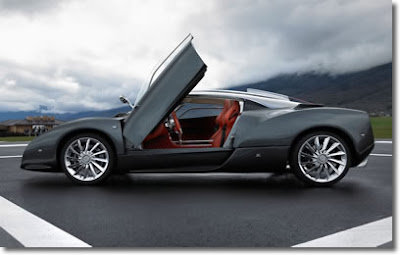 Spyker C12 Zagato: The Rationale
Spyker C12 Zagato: The Rationale
After it became apparent that Spyker would succeed in acquiring the Midland Formula 1 team it was decided that the C12 Zagato should embody as many of the Formula 1 design cues as practically possible so as to set a new design vision for future Spyker road car models.
In the months following that decision, Spyker and Zagato finalized the design and the manufacturing of the C12 Zagato was entrusted to Spykers long time fabrication partner, Coventry Prototype Panels in
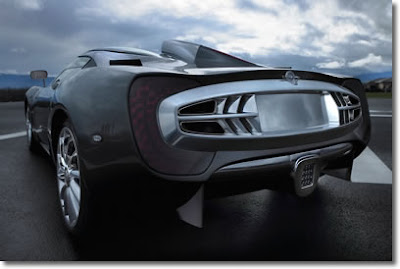 Spyker C12 Zagato: The Vehicle
Spyker C12 Zagato: The Vehicle
The Spyker C12 Zagato is an all aluminum rear wheel drive sports car, based on the Spyker C12 Spyder. The C12 is powered by the 6.0 liter, 12 cylinder, 500 bhp W12 engine from Volkswagen AG and accelerates from 0-62 mph in 3.8 seconds. The Spyker C12 Zagato is equipped with a six-speed manual or automatic gear box with F1 style shifting, Chronoswiss instruments and a Zagato designed full leather interior with brushed aluminum instrument panel. The C12 Zagato has an aluminum body with stainless steel roof rails and has many F1 derived design details such as an F1 nose, air scoop, chimneys, mirrors, rain light, fuel flap and diffuser. It has a panoramic roof that features the Double Bubble, a typical Zagato style element. The Spyker C12 Zagato has a length of 177.4 inches, a width of 80 inches excluding mirrors, a height of 49.2 inches and weighs 3262 lbs. Top speed is 193 mph.
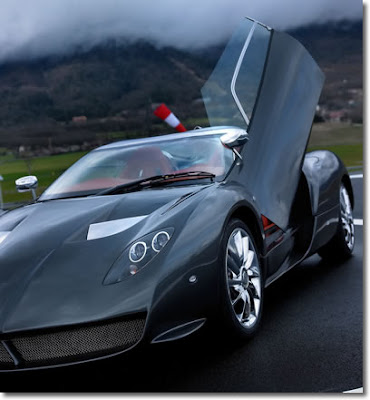 "The Spyker and Zagato Atelier brands perfectly align because of their common aeronautical origins and because of the shared passion of Victor Muller and myself for sports cars," states Andrea Zagato. "Nevertheless Victor, before starting this extraordinary adventure with Spyker, was a Zagato collector owning cars like the Flaminia SS and TZ. Together with our neo-classical approach, this Spyker C12 Zagato shows the capabilities of Zagato Atelier for innovative and non conventional solutions."
"The Spyker and Zagato Atelier brands perfectly align because of their common aeronautical origins and because of the shared passion of Victor Muller and myself for sports cars," states Andrea Zagato. "Nevertheless Victor, before starting this extraordinary adventure with Spyker, was a Zagato collector owning cars like the Flaminia SS and TZ. Together with our neo-classical approach, this Spyker C12 Zagato shows the capabilities of Zagato Atelier for innovative and non conventional solutions."
Norihiko Harada, designer of the new Spyker C12 Zagato, adds: "All Spyker cars have their own very unique style: the aeronautical retrospective style co-exists with craftsmanship and elegance. The new Zagato body becomes even more unique, aggressive and sensual at the same time. It features a new double bubble panoramic roof , F1 influenced nose and air intakes, chimney and a coda tronca, the typical Zagato cut off tail end."
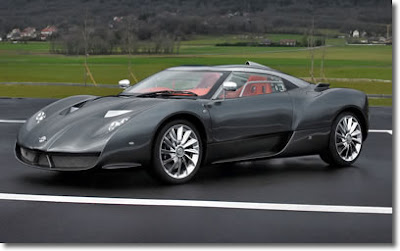 Maintaining Spykers styling philosophy, Zagato design put all these elements together and created an extremely stimulating example of contemporary exotic high performance sports car by using typical modern Zagato lines which started from the Raptor Zagato in 1996.
Maintaining Spykers styling philosophy, Zagato design put all these elements together and created an extremely stimulating example of contemporary exotic high performance sports car by using typical modern Zagato lines which started from the Raptor Zagato in 1996.
| Specifications | |||||||||||||||||||||||||||||||||||
Base Price: $644,000 | | ||||||||||||||||||||||||||||||||||
Source: RSportscars
2008 SSC Ultimate Aero TT
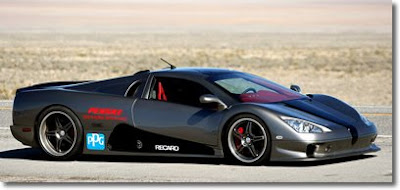
Shelby SuperCars spent more than seven years designing, developing, and executing the ultimate driver's car. The result is the Ultimate Aero TT.
Powered by a forced induction V8 engine (with Chevrolet roots), the two-seat super car is for the guy or girl whose neighbors all probably drive Lambos, Ferraris, or Carrera Gts, and he or she just wanted something a little different.
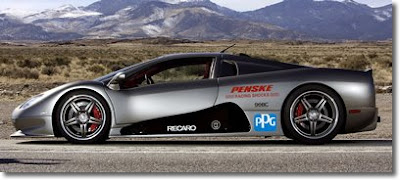 Made completely of carbon fiber composite, save for the doors, hood and trunk, the body has a total weight of 131 lbs (Before the addition of all other components). The Aero TT is powered by a 387.2 cubic-inch twin-turbocharged V8 that achieves 1183 horsepower at 6950 rpm, with 1094 pound-feet of torque.
Made completely of carbon fiber composite, save for the doors, hood and trunk, the body has a total weight of 131 lbs (Before the addition of all other components). The Aero TT is powered by a 387.2 cubic-inch twin-turbocharged V8 that achieves 1183 horsepower at 6950 rpm, with 1094 pound-feet of torque.
The mid-engine, rear drive layout of the Aero TT, helps add to the downforce needed to put the nearly 1200 horsepower to the ground. Performance is so potent that the Guiness World Records verified in October 2007 that with twin passes that averaged 256.18 mph, the Aero TT is officially the "Fastest Production Car in the world." This is the first time since the Ford GT40 held the record in 1967, that an American manufacturer has held the title. Estimated top speed in the Aero TT is 273 mph.
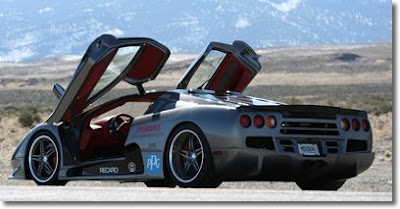 Creature comforts inside the Aero TT include a custom leather interior, air conditioning, power windows and mirrors, 10 speaker premium audio/video system, DVD Navigation/Backup camera and a gas controlled front lift to help navigate road hazards.
Creature comforts inside the Aero TT include a custom leather interior, air conditioning, power windows and mirrors, 10 speaker premium audio/video system, DVD Navigation/Backup camera and a gas controlled front lift to help navigate road hazards.
The Shelby SuperCars Ultimate Aero TT is the hotrod for those who feel the garden variety of supercars are too common. With production scheduled for around 25 cars, you will certainly be running in very rare air.
Source: LeftLane
2008 Chevrolet Racing Corvette C6.R E85
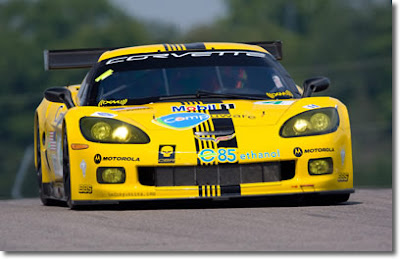
| Specifications | |||||||||||||||||||||||||||||||||||||
| | ||||||||||||||||||||||||||||||||||||
After winning its seventh consecutive GT1 manufacturers and team championships in 2007 using E10 (10 percent ethanol), Corvette Racing's twin Compuware C6.R race cars made the transition to E85 for the 2008 season.
 "Since its inception, Corvette has always been a platform for Chevrolet and GM to introduce and develop new technology," Chevrolet general manager Ed Peper said in January at the North American International Auto Show in Detroit, where the announcement was made "The use of E85 ethanol fuel by America's premier production sports car racing team in a high-profile, high-tech racing series like the ALMS shows that Chevy is continuing to lead by example.
"Since its inception, Corvette has always been a platform for Chevrolet and GM to introduce and develop new technology," Chevrolet general manager Ed Peper said in January at the North American International Auto Show in Detroit, where the announcement was made "The use of E85 ethanol fuel by America's premier production sports car racing team in a high-profile, high-tech racing series like the ALMS shows that Chevy is continuing to lead by example.
"By showcasing the capabilities of E85 ethanol before an audience of knowledgeable and technically astute race fans, we can demonstrate the benefits of a renewable fuel that helps to reduce dependence on petroleum, helps to reduce emissions of greenhouse gases, and helps to create greater diversity in energy supplies," Peper said. "Of course, performance is what counts in racing, so E85 ethanol's higher octane rating than gasoline wasn't overlooked by the Corvette Racing engineers."
 Corvette Racing has formed a technical partnership with the Ethanol Promotion and Information Council (EPIC) to spotlight E85 in the ALMS. EPIC worked with ALMS officials to make E85 the fuel of choice for the series. E85 today is primarily made with grain-based ethanol that reduces carbon dioxide emissions by as much as 29 percent compared with pure gasoline.
Corvette Racing has formed a technical partnership with the Ethanol Promotion and Information Council (EPIC) to spotlight E85 in the ALMS. EPIC worked with ALMS officials to make E85 the fuel of choice for the series. E85 today is primarily made with grain-based ethanol that reduces carbon dioxide emissions by as much as 29 percent compared with pure gasoline.
E85 ethanol already is an option for millions of everyday drivers – and GM leads the automotive industry with more than 2.5 million E85-capable cars, trucks and SUVs on the road in the
“This is the first time a racing series has made a commitment to E85, the highest-performing fuel available to consumers with flex-fuel vehicles,” said Reece Nanfito, senior director of marketing for EPIC. "Our partnership with GM and Corvette Racing demonstrates ethanol’s growing relevance in the consumer market.”
 Corvette Racing's transition from E10 to E85 ethanol was seamless, according to Steve Wesoloski, GM Road Racing Group manager. "The race cars' fuel systems were already 100-percent compatible with ethanol, so our preparation for the change to E85 in 2008 basically came down to recalibrating the engines.
Corvette Racing's transition from E10 to E85 ethanol was seamless, according to Steve Wesoloski, GM Road Racing Group manager. "The race cars' fuel systems were already 100-percent compatible with ethanol, so our preparation for the change to E85 in 2008 basically came down to recalibrating the engines.
"GM Racing has had an interest in 'green racing' initiatives worldwide for some time," Wesoloski said. "In 2007, Corvette Racing won the Michelin Energy Endurance Challenge in the GT1 class at the 24 Hours of
Official Chevrolet Racing Press Release
Source: RSportscars
2009 Pagani Zonda Cinque
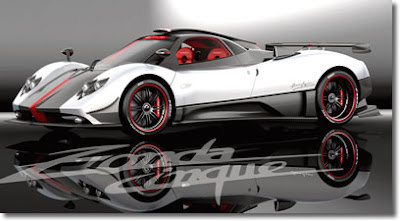
The 2009 Pagani Zonda Cinque is a super special limited edition--as in only five (5) of these ridiculous Italian sports cars will be produced. Italian supercar maker Pagani has had a hit with the handbuilt Zonda series, which are so exclusive that they are selling for far more than their greater-than-$1 million base price.
The 2009 Zonda Cinque flies, with a Mercedes AMG-sourced engine crammed into an ultralight body made of carbon-titanium fiber, a material developed in conjunction with Pagani just for the Zonda Cinque. Weight savings and drivetrain refinements allow the Zonda Cinque to rocket from 0-100 km/hr (62 mph) in just 3.4 seconds, faster than... almost anything.

No word on whether the five limited-edition 2009 Pagani Zonda Cinque supercars are accounted for, but don't bet on getting one. The price? A cool 1 million Euros. Plus tax.
| Specifications | |||||||||||||||||||||||||
Base Price: . $1,565,000 | | ||||||||||||||||||||||||
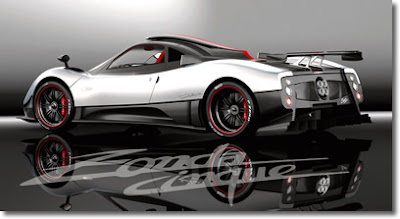
The interiors are refined and at the same time reveal the sporting attitude of this car. Racing leather seats developed by Toora, 4-points seatbelts and molibden steel roll-bars with carbon fiber coating.
The Zonda Cinque total weight will be 20 Kg lighter then the F model, will have new Pirelli tyres, with special compounds for the car.
Suspensions and springs will be in ergal and titanium developed with the latest technology from Öhlins, in accordance with the Pagani specifications. Four different settings, 10 adjustments each, to separate high and low frequencies, both in compression and extention.
 The body is equipped with a longer front spoiler, new designed rear wing, central air intake on monocock, extra air intakes for rear brakes. Flat bottom and new rear air extractors will improve the downforce up to 750 Kg at 300km.
The body is equipped with a longer front spoiler, new designed rear wing, central air intake on monocock, extra air intakes for rear brakes. Flat bottom and new rear air extractors will improve the downforce up to 750 Kg at 300km.
The Zonda Cinque will be a piece of art able to speed over 350 Km/h. A special colour livery will distinguish this unique, exclusive, 1ML Euro + tax model. Only five pieces for five wealthy Pagani lovers.
Source: RSportscars
2008 Mosler MT900 GTR XX
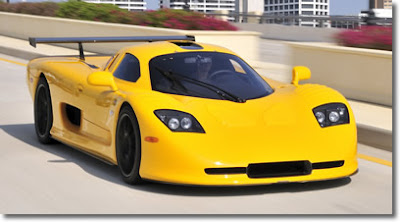
The Mosler MT900 GTR-XX, released as a Europe-only model to commemorate the American super sports car manufacturer's 20th anniversary, is equipped with the supreme performance specs that bring the MT900 GTR series into rare air among the supercars of the world.


Mosler has taken great strides to save weight with the MT900 GTR-XX, which carries a curb weight of only 2450 pounds. With 600 horsepower on tap, this translates to performance numbers rarely seen south of Bugatti. With "Lambo" doors and styling representing a Corvette in its Sunday best, on steriods, the MT900 GTR-XX is destined to grace the wall calendars of many supercar fanatics worldwide.
But looks and straight-line top speed aren't the only advantages the MT900 GTR-XX, priced at well over $300,000 equivalent USD, offers its driver. Mosler promises a skidpad figure of at least 1.1g for this greatest of MT900 special editions, translating into balanced and razor-sharp handling on the road and on the track.
American national sports car buyers won't be getting a crack at the Mosler MT900 GTR-XX, but the 50-state legal 2008 MT900S offers most of the same performance features, and retails for $329,000.
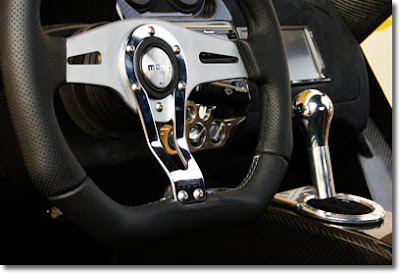

| Specifications | |||||||||||||||||||||||||||||||||
Base Price: $329,000 | | ||||||||||||||||||||||||||||||||
MOSLER AUTOMOTIVE CELEBRATES 20th Anniversary
One of the World’s Most Unique Supercar Manufacturers Commemorates its 20th Year of Dominating Performance with the New MT900 GTR-XX European Model
[Courtesy Mosler Automotive Press Release]
Riviera Beach Fla. (June 2008) – Mosler Automotive announces the first delivery of its 20th anniversary model, the MT900 GTR XX, to German distributor Christof Flugel. The new MT900 GTR XX continues the legacy established by founder Warren Mosler with the company’s first
In 1988 Mosler Automotive was the first manufacturer to utilize advance composite construction for primary structures of the
“Total performance is everything,” says Warren Mosler. “In a 2003 Motor Trend event, an early MT900 with only 400 hp officially set 9 performance records, including 0-60mph in 3.1 seconds and 1.06g’s on the skid pad. The new MT900 GTR XX with 600 hp will be tested in
The Mosler MT900R race vehicles begin life as a road car with subsequent modification for compliance with the racing sanctioning organizations. Over the years the MT900R has built an impressive list of international motorsports achievements, including winning overall championships in British and Spanish GT series and numerous individual victories including the Rolex 24 Hours of Daytona, the prestigious International GT Open in
Simultaneously, the extreme performance
The company’s street-legal and race ready Mosler MT900’s feature superior power to weight ratios for superior total performance and fuel efficiency. Utilizing an advanced composite carbon fiber monocoque and Kevlar® construction, the MT900 GTR-XX weighs only 2450 pounds, allowing the driver to brake deeper, carry higher speeds into and through the corners, and accelerate harder. Double-wishbone chromoly upper and lower control arms, adjustable coil-over shocks and adjustable blade anti-roll bars work together to keep the MT900 GTR XX glued to the road with over 1.1g capability on street tires. Combined with the 7 liter 600 hp alloy V8 and 6 speed transaxle, the Mosler is an unparalleled state-of-the-art supercar.
“As we enter our 20th year, Mosler Automotive continues to embrace the fundamentals of performance technology” explains Mosler.
The 50-state legal MT900S is priced at $329,000 and available exclusively through one of
Source: RSportscars
2008 IMSA Lamborghini Murcielago GTR
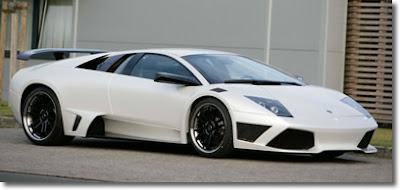
World exclusive: The brand new imsa technical and aerodynamic-enhancement program for the Lamborghini Murcielago LP640.
Imsa, the world-acclaimed, German High-Tech Engineering specialist, exclusively presents, after successfully introducing the stunning imsa GTV Supercar based on all versions of the Lamborghini Gallardo, its new technology and design-enhancement program for Lamborghini’s current top-of-the-range supercar, the Murcielago LP640.
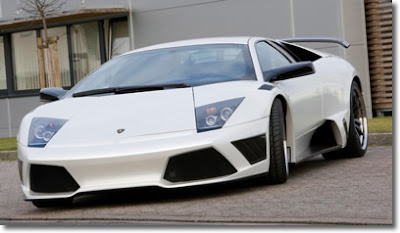
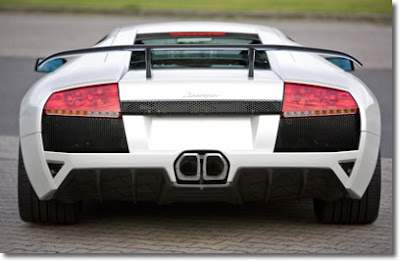
Special emphasis must be laid on the technology- and design-package made from Autoklav moulded carbon fibre. Technology which is normally only being used in Formula 1 and other Top-motorsports Series. Imsa’s main target was, for all owners of the Lamborghini top-of-the-range-model, to offer an exclusive product line, transforming the Murcielago both technically and optically into a unique work of art, with the aim of significantly enhancing the exclusivity of Lamborghini’s Top-model.

The strikingly aggressive and aerodynamically highly effective front apron (spoiler) perfectly aligned to the wheel arches (widened 35mm on each side), directly becomes apparent. On the upper side of the wheel arches, imsa CFK air ducts have been integrated, resulting in a significant reduction of the drag effect caused by non-aerodynamic airflow at higher and highest velocity. The imsa side-skirts on the underside guarantee the optimum airflow to the imsa diffuser, which has been developed for an aerodynamically perfect interaction with the imsa rear spoiler. Imsa herewith achieved to considerably lower the downforce at higher and highest speeds. The benefits for the driver are a significant enhancement of driving stability, safety and enjoyment.

All parts of the imsa-aerodynamic-enhancement program are either available in carbon-onsight or can be painted in any colour of choice. The imsa aerodynamic-enhancement-program is available from November 2007 on and will soon be available for the “standard” Murcielago as well. The imsa technical enhancement program also includes – exactly as for the imsa GTV Supercar based on the Lamborghini Gallardo – exclusive imsa multi-part sports wheels with central locking system, various sports chassis with individual settings, and, last but not least, various imsa engine modifications and own engines. At imsa, each customer is fully involved in the creation of his personal, unique imsa-Megacar handcrafted according to highest German standards of quality and precision. Additionally, personalised tailor-made interiors inclusive of various multi-media applications are also being fitted on special request.
| Specifications | |||||||||||||||||||||||||||||||||||
| | ||||||||||||||||||||||||||||||||||
Source: RSportscars
2009 Koenigsegg CCXR Edition

Koenigsegg has produced one of the most visually inspiring supercars to date, the 2009 Koenigsegg CCXR Edition. The Edition is an ultra exclusive edition of the Koenigsegg CCXR, one of the top 5 fastest production cars in the world. With a beautiful body done all in unpainted carbon fiber, the CCXR Edition makes no pretense of presenting itself as a luxury car.
The CCXR Edition is a driver's car, pure and simple. While completely street legal in
Perhaps even more impressive is the Koenigsegg CCXR Edition's lateral g-force of 1.5 G. In the hands of the right driver, this is among the most capable sports cars in the world. The Koenigsegg CCXR Edition is only available by special order in a very limited run of, count them, 6 production models.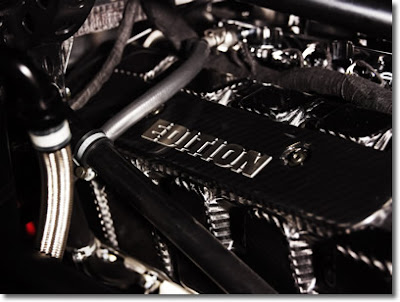
Icing on the cake is that the CCXR Edition has been retrofitted with the ability run on biofuel, premium gasoline or a mixture of both. Because of the combustion characteristics of E85 Ethanol fuel, the CCXR Edition actually is able to utilize its full 1018 horsepower only when running off this type of fuel. A corn-powered 250 mph+ supercar? Sign us up!
| Specifications | |||||||||||||||||||||||||||||||||||
| | ||||||||||||||||||||||||||||||||||
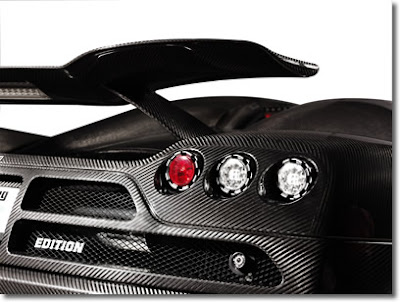
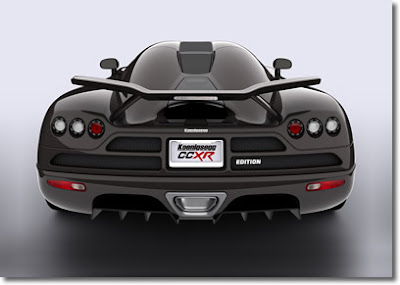
WORLDWIDE PREMIERE OF THE KOENIGSEGG EDITION - GENEVA 2008
[Info Courtesy Koenigsegg]
On
The Edition is the ultimate supercar – a Koenigsegg at its most extreme - built to break records and deliver breathtaking performance. Only a very few models will be produced, in order to ensure exclusive status amongst supercar owners.
It has a clear, fully visible carbon fibre body, and is available in two versions: the 4.8 litre 888bhp CCX Edition and the CCXR Edition, which can be driven on environmentally friendly ethanol E85 and E100 fuels, as well as regular petrol. When run on E85 fuel the 4.8 litre engine produces 1018 bhp.
Furthermore there are many unique details on the car. The new forged, machined and polished aluminium Edition wheels for example, which are extremely light and incorporate optimum brake cooling. The bright, polished surface of the wheels was chosen to maximize the contrast against the exclusive black clear carbon body.
The Edition interior is clad in striking red leather and features a special version of the Koenigsegg Chronocluster including a redesigned centre console. All the interior aluminium parts are anodized in a specially formulated Koenigsegg Edition tone that has a unique and purposeful look.
The Edition has a high performance specially developed rear wing, a larger front splitter plus side front strakes. The aerodynamics have been verified and optimized in CFD and in real life on the Koenigsegg test track in
One of the keys to Koenigsegg’s success, and what distinguishes it from every other supercar manufacturer, is the fact that they are able to build, modify, tune and test their own engines, which means that every engine is precision-made to suit the car it is built for. Furthermore, they are able to fabricate intricate hand-made components at their own hi-tech production facilities, as well as being able to source specialist components from a network of dedicated specialist suppliers and partners - most of which are based in Sweden.
Many of these suppliers are small companies and craftsmen that produce low volumes of incredibly high quality components. Both the assembly and the manufacture of the components that make up a Koenigsegg are incredibly labour-intensive (there are more than 300 hand-formed carbon fibre parts alone in each car, for example), and the materials are without exception extremely costly. Each and every Koenigsegg has a premium price, but then each and every Koenigsegg has been painstakingly built by a select group of automotive artisans.
Source: RSportscars
2010 Audi R8 GT3

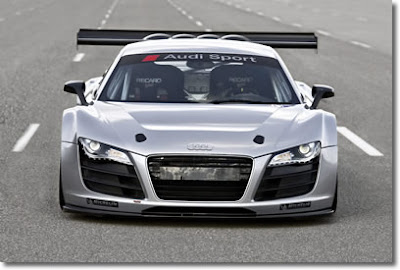 Homoglamated production race cars such as the 2010 Audi R8 GT3 are an exciting consumer perk required by the rules of some race series. In the past, the rule set which calls the R8 GT3 into production has brought us such cars as the BMW M3 CSL, Mercedes-Benz 190 Evolution II and the Porsche 911 GT3 Cup. Mechanically speaking, the 2010 R8 GT3 features several changes from the production car.
Homoglamated production race cars such as the 2010 Audi R8 GT3 are an exciting consumer perk required by the rules of some race series. In the past, the rule set which calls the R8 GT3 into production has brought us such cars as the BMW M3 CSL, Mercedes-Benz 190 Evolution II and the Porsche 911 GT3 Cup. Mechanically speaking, the 2010 R8 GT3 features several changes from the production car.
 As per GT3 regulations, Audi ditches the Quattro AWD system characteristic of the R8 in favor of a RWD setup. Rest assured the team at Audi Sport is putting significant attention into the RWD system used in the R8 GT3. The
As per GT3 regulations, Audi ditches the Quattro AWD system characteristic of the R8 in favor of a RWD setup. Rest assured the team at Audi Sport is putting significant attention into the RWD system used in the R8 GT3. The
Rounding out known info for the performance upgrades on the 2010 Audi R8 GT3 are a menacing track-ready aerodynamics kit promising greatly increased downforce and handling prowess, a 6 speed sequential manual transmission, and a gasoline motor promising more than 500 horsepower.
 Which brings us to the next question. Will the 2010 Audi R8 GT3, or Audi R16 if you prefer, be street legal? Audi has not released the official word on this yet, saying only that the R8 GT3 "will offer customers a racing sports car equipped with high-calibre technology and the typical Audi qualities, but which is nevertheless easy to handle."
Which brings us to the next question. Will the 2010 Audi R8 GT3, or Audi R16 if you prefer, be street legal? Audi has not released the official word on this yet, saying only that the R8 GT3 "will offer customers a racing sports car equipped with high-calibre technology and the typical Audi qualities, but which is nevertheless easy to handle."
Below is the first info direct from Audi AG, reprinted in full. More details on the 2010 Audi R8 GT3 will be posted as they arise.
| Specifications | |||||||||||||||||||||||||||
| | ||||||||||||||||||||||||||

 Audi develops race version of the R8
Audi develops race version of the R8
Official Audi AG Press Release
- * Customer sport programme with the mid-engine sportscar,/li>
- * First races planned for 2009 season
- * Factory driver Frank Biela completes roll-out
"The R8 is the first production Audi bearing the name and genes of a successful racing sportscar and is therefore an excellent base from which to build up our first big customer sport programme," explains Head of Audi Motorsport Dr Wolfgang Ullrich. "Ever since the R8 was unveiled we’ve been inundated with enquiries about a race version. With the Audi R8 we will offer customers a racing sportscar equipped with high-calibre technology and the typical Audi qualities, but which is nevertheless easy to handle."
The Audi R8 conforms to the production-based GT3 regulations allowing the car to be fielded in numerous national and international race series.
Because the GT3 regulations prohibit the use of four-wheel drive the Audi R8 comes with the typical GT rear-wheel drive. The power is transmitted via a newly developed six-speed sequential sports gearbox. The suspension uses almost exclusively components from the production line. A comprehensive list of safety equipment guarantees the highest-level of passive safety. A modified front end and a large rear-wing generate the required downforce for the race track.
The Audi R8, which bears the project name "R16" within Audi Sport, was developed under the direction of Audi Sport. Mid August, the first prototype successfully completed a roll-out in the hands of Audi factory driver Frank Biela.
The first test races in various European racing series are scheduled for the 2009 season. Delivery to the customers is planned from the autumn of this coming year.
The customer cars are manufactured together by Audi Sport and the quattro GmbH, which is also responsible for production of the Audi R8 street version, and Audi Hungaria Motor Kft. (Györ).
Source: RSportscars
2009 Alfa Romeo 8C Competizione
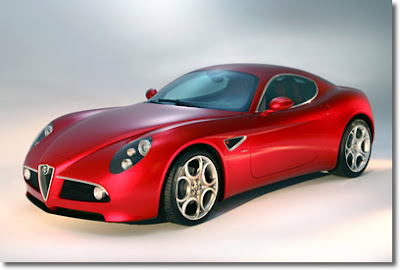
The engine is from another Italian thoroughbred, Maserati's Quattroporte, although it's been enlarged to 4.7 liters of displacement. It makes 444 horsepower at 7,000 rpm, and 347 lb-ft of torque at 4,750 rpm, with a 7,500 rpm redline. That engine will be placed behind the front axle for a low center of gravity and ideal weight distribution.
 The sole transmission choice will be a six-speed sequential manual with paddles, mounted as part of the rear axle for better weight distribution, as is the current vogue. The Q-Select gearbox will have five distinct modes: Manual-Normal; Manual-Sport; Automatic-Normal; Automatic-Sport and Ice.
The sole transmission choice will be a six-speed sequential manual with paddles, mounted as part of the rear axle for better weight distribution, as is the current vogue. The Q-Select gearbox will have five distinct modes: Manual-Normal; Manual-Sport; Automatic-Normal; Automatic-Sport and Ice.
 The car's carbon-fibre body hides a steel unibody close to that of the Maserati coupe as well. The underbody was shaped in the wind-tunnel to reduce lift at the high speeds the car will no doubt be able to achieve without so much as breaking a sweat.
The car's carbon-fibre body hides a steel unibody close to that of the Maserati coupe as well. The underbody was shaped in the wind-tunnel to reduce lift at the high speeds the car will no doubt be able to achieve without so much as breaking a sweat.
A high-threshold stability control system is on the cards as well, working with the double-wishbone suspension to keep the car on the road.
Tires are to be Pirelli's P-Zero Corsa, with six-piston, cross-drilled and vented brakes up front and four-piston rear brakes testing their traction abilities.
Apparently Alfa plans on building 500 8Cs in
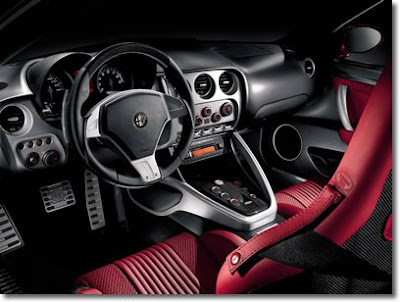
 The car shares its name with the Alfa Romeo 8C 2009 from 1934, which dominated the 1000 Miglia race in 1935-1938 and 1947. It was powered by an inline-8 engine.
The car shares its name with the Alfa Romeo 8C 2009 from 1934, which dominated the 1000 Miglia race in 1935-1938 and 1947. It was powered by an inline-8 engine.
Source: LeftLane
Alfa Romeo 8C Spider
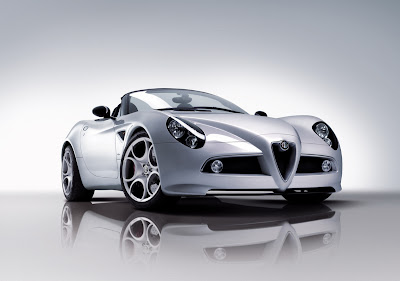
A drop-top version of the gorgeous 8C Competizione coupe, the Spider was seen at the Pebble Beach Concours d'Elegance in
The engine powering both coupe and convertible is from another Italian thoroughbred, Maserati's Quattroporte, although it's been enlarged to 4.7 liters of displacement. It makes 450 horsepower at 7,000 rpm, and 347 lb-ft of torque at 4,750 rpm, with a 7,500 rpm redline. The Ferrari-built motivator will be placed behind the front axle for a low center of gravity and ideal 50/50 weight distribution.
 The sole transmission choice will be a six-speed sequential manual with paddles, mounted as part of the rear axle for better weight distribution, as is the current vogue. The Q-Select gearbox will have five distinct modes: Manual-Normal; Manual-Sport; Automatic-Normal; Automatic-Sport and Ice.
The sole transmission choice will be a six-speed sequential manual with paddles, mounted as part of the rear axle for better weight distribution, as is the current vogue. The Q-Select gearbox will have five distinct modes: Manual-Normal; Manual-Sport; Automatic-Normal; Automatic-Sport and Ice.
The car's carbon-fibre body hides a steel unibody close to that of the Maserati coupe as well. The underbody was shaped in the wind-tunnel to reduce lift at the high speeds the car will no doubt be able to achieve without so much as breaking a sweat.
A high-threshold stability control system is on the cards as well, working with the double-wishbone suspension to keep the car on the road.
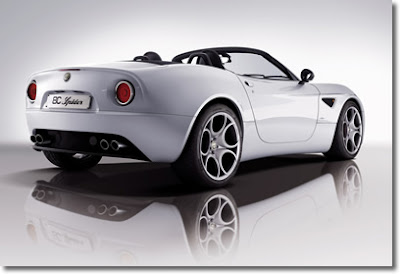 Tires are to be 20-inch versions of Pirelli's P-Zero Corsa, with six-piston, cross-drilled and vented brakes up front and four-piston rear brakes testing their traction abilities.
Tires are to be 20-inch versions of Pirelli's P-Zero Corsa, with six-piston, cross-drilled and vented brakes up front and four-piston rear brakes testing their traction abilities.
The car shares its name with the Alfa Romeo 8C 2009 from 1934, which dominated the 1000 Miglia race in 1935-1938 and 1947. It was powered by an inline-8 engine.
Specifications
| Brakes & Tires | |
| Front Suspension | 245/35 |
| Rear Suspension | 285/35 |
| Engine | |
| Displacement cu in (cc) | 4700 cc |
| Horsepower | 450 CV at 7.000 rpm |
| Maximum Torque | 7.500 rpm |
| Torque lb-ft (Nm) at RPM | N/A |
| Transmission | 6-Speed F1 |
| Type | 4.7-liter V8 engine |
| Exterior Dimensions & Weight | |
| Height | N/A |
| Length | N/A |
| Wheelbase | N/A |
| Width | N/A |
| Performance | |
| 0-60 mph | N/A |
| Top Speed mph (km/h) | N/A |
Base Price: $265,000
2007 Lamborghini Reventon
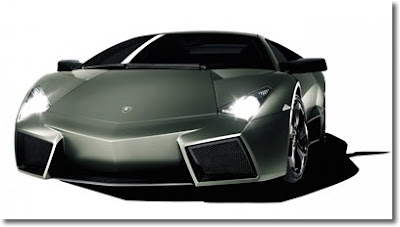
Clearly a Lamborghini, but nothing quite like it. A super car without equals: the Lamborghini Reventon is a road vehicle with an extreme specification and, at the same time, a limited edition masterpiece – a coherent style, angular with sharp lines, inspired by the very latest aeronautics.
With just 20 produced, each 1 Million Euro (without taxes) Lamborghini Reventon is a symbol of extreme exclusivity, yet still offering the extraordinary performance that makes the Reventon so unrivalled: under the completely autonomous design, the Reventon possesses the entire technical and dynamic competence of the twelve cylinder Lamborghini.
| Specifications | |||||||||||||||||||||||||||||||||||
Base Price: Approx. 1,000,000 € | | ||||||||||||||||||||||||||||||||||
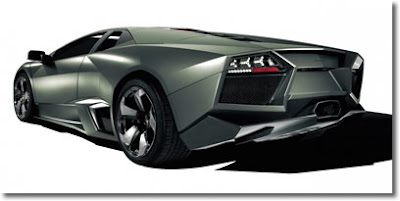
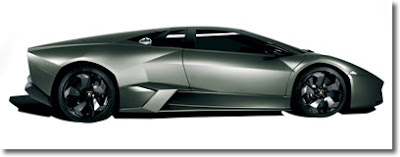
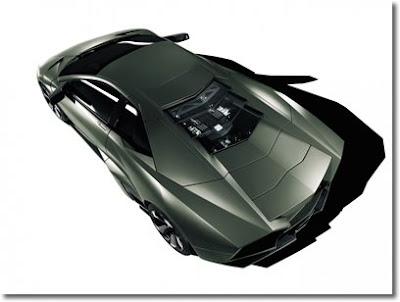 Born in Sant’Agata Bolognese
Born in Sant’Agata Bolognese
The Lamborghini Reventon has been entirely designed in Sant’Agata Bolognese, the original birthplace of the Lamborghini and the native home of every super car born under the sign of the bull. The design drawn up in Lamborghini’s Centro Stile (
The Lamborghini Reventon is not destined to remain a one-off. A total of 20 Lamborghini friends and collectors will be able to own this extraordinary car and, naturally, enjoy the incomparable pleasure of driving it.
The name Reventon has been chosen according to Lamborghini tradition. Reventon was a fighting bull, owned by the Don Rodriguez family. It is included in the list of the most famous bulls ever and is known for killing the famed bullfighter Felix Guzman in 1943.
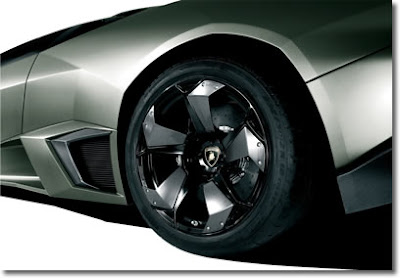 Made of Carbon Fiber
Made of Carbon Fiber
Although it is based on the extraordinarily successful Murcielago LP640, the exterior design of the Reventon is completely new. Just like the base model, the exterior is made of CFC, a composite carbon fiber material, which is as stable as it is light. The exterior components are glued and fixed to the body comprised of CFC and steel.
The front is characterized by the acute angle of the central ‘arrow’ and by the powerful forward-facing air intakes. Although they do not supply air directly to the turbine like an airplane, bearing in mind the 650 hp, an abundant volume of air is necessary to cool the carbon brake disks and the six cylinder calipers.
Characterised by Coherent Functions
Naturally, both doors on the Reventon open upwards – since the legendary Countach this has also been a symbol of the V12 Lamborghini product line. With their asymmetric configuration, the large air intakes below the doors provide an example of the extreme coherence with which a Lamborghini fulfils its function: on the driver's side it is large to increase the flow of oil to the radiator. On the passenger’s side of the vehicle, the air intake is flat because in this case, it only has to ensure the flow below the floor. The aerodynamically optimized flat floor structure terminates at the rear with a diffuser featuring an accentuated shape. This guarantees excellent road grip and stability even at 200 mph.
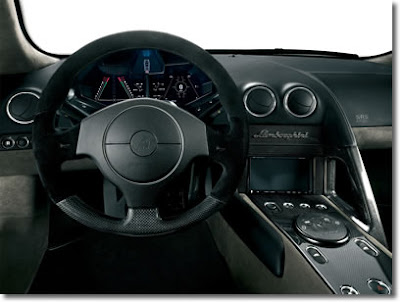

A Masterpiece with Tested Technology
The technology found in the Murcielago LP640 has not been modified. The engine in the LP640 forwards is the classic twelve-cylinder engine with 6.5 liter displacement. Only for this car, Lamborghini guarantees, an astounding 650 bhp at 8,000 revolutions per minute (rpm). The huge torque, equal to maximum 487 lb-ft, ensures a powerful switch from any number of revolutions: even the slightest pressure on the accelerator is spontaneously transformed into thrust. The robotised e.gear changes gear faster than even the most expert driver. In addition, the permanent Viscous Traction four-wheel drive system ensures that every force is constantly translated into movement.
With the Lamborghini Reventon, Lamborghini has done it again; it has created an unequalled super car; the perfect synthesis between the exclusivity and appeal of a limited edition design masterpiece, and the dynamism and driveability of a standard sports car. Thus, the Lamborghini legend is further enhanced by another, stylish future classic.
2009 Subaru WRX STi 330S
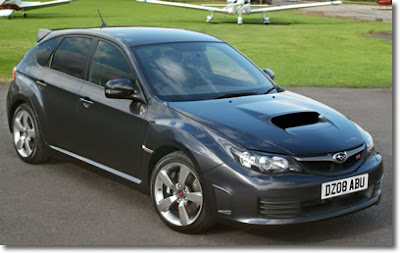
The new Subaru WRX STi 330S, just announced for a UK release at the British International Motor Show, is exactly the car last years WRX STi should have been. Put it slightly more drastically, and the WRX STi 330S is the car Subaru needed. The polarizing new "standard" STi has more buyers turning toward Mazda and Mitsubishi, and the once-lofty WRX brand has now been victim to descriptions such as a "tuner Corolla." Not exactly what Japanese AWD specialists Subaru had envisioned.
The Subaru WRX STi is at or near the top of every young car fan's list, and with good reason. The Subaru WRX series, in the last 10 years or so, has provided unmatched driving excitement in its base price point, and the WRX STi takes the formula even further, creating a true hardcore sports car that happens to come in four-door compact form.
This is why many Subaru diehards and automotive fans were more than a little disappointed when the other Blue Oval decided to soften the WRX and WRX STi for 2008, in attempt to make strides in ride comfort and mainstream styling, a move not embraced by many of Subaru's most vocal fanatics and critics.
The 2009 Subaru WRX STi 330S, set for a
Other nice touches include leather-trimmed Recaro racing seats, and burnout-ready 245/40 R18 tires mounted on beautiful 18 inch alloys. Look for design cues from the Subaru WRX STi 330S to be incorporated into the soon-to-be-announced 2009 Impreza line.
| Specifications | |||||||||||||||||||||||||
Base Price: £30,000 | | ||||||||||||||||||||||||
Read on for full official details, direct from the British International Motor Show...
 HIGH-PERFORMANCE HAT-TRICK FROM SUBARU
HIGH-PERFORMANCE HAT-TRICK FROM SUBARU
[Press Release]
* Three new high-performance Special Edition Imprezas
* 255 PS Impreza WRX-S at £22,495 OTR
* 330 PS Impreza WRX STI 330S for around £30,000 OTR
* Ultimate 380 PS Impreza WRX STI 380S concept
Subaru has scored a high-performance hat-trick for the British International Motor Show with the launch of no less than three new Special Edition new-shape Impreza models – two of which can be seen at the show.
All receive Prodrive engine upgrades plus comfort and styling tweaks, giving enthusiasts an unprecedented choice of sporty Subarus.
The 255 PS Impreza WRX-S costs a highly-competitive £22,495 while the 330 PS Impreza WRX STI 330S will be priced at around £30,000 (both on-the-road). First deliveries are expected in September.
Still in concept stage is the 380 PS Impreza WRX STI 380S which could become available within the next six months pending positive customer response.
Visitors to the show (July 23 to August 3, ExCeL,
Impreza WRX-S Offers More Power And Style
Based on the new Impreza WRX, the 'S' model offers £4,500 worth of extras for a £2,500 premium, costing £22,495 OTR.
Banbury-based Prodrive has re-programmed the 2.5 litre 'boxer' engine's ECU (electronic control unit) and modified the exhaust system. This sees power leap from 230 PS at 5,200 rpm to 255 PS at 5,400 rpm while the torque improvement is even greater, growing from 236 lb.ft at 2,800 rpm to 287.6 at 3,000 rpm – a staggering 51 lb. ft more.
Maximum speed remains at 130 mph but the 0-60 mph time drops from 6.1 seconds to 5.5 seconds. Naturally, in-gear flexibility is greatly enhanced.
The new Impreza WRX-S also boasts 18x7.5 ins anthracite GT1 alloy wheels with 225/40 tyres, an STI front grille, STI front lip spoiler and STI rear wing and body-colour tailgate moulding.
Also standard is a MOMO 'Air-Race' gearknob while the colour choice is between San Remo Red, WR Blue Mica, Obsidian Black Pearl and Satin White Pearl.
Standard equipment on the Impreza 2.5 WRX-S includes front and rear spoilers, side skirts, a rear diffuser, leather-covered steering wheel, all-wheel drive, a rear limited-slip differential with Subaru Vehicle Dynamics Control, 10-speaker, six-disc radio/CD player and xenon headlamps.
Impreza WRX STI 330S Brings Back The Burble
The new Impreza WRX STI 330S also benefits from a Prodrive Performance pack with modified ECU and exhaust system – this time with paired twin 90 mm diameter stainless steel exhaust pipes to bring back the burble so loved by 'scooby' fans.
Power goes up to 330 PS at only 5,400 rpm compared to the 300.5 PS at 6,000 rpm of the standard model.
Torque is boosted from 300.2 lb ft at 4,000 rpm to 346.6 lb ft at a lower 3,400 rpm making for an even swifter, effortless driving experience.
Top speed is the same 155.3 mph but the 0-60 mph time drops from an already swift 4.8 seconds to only 4.4 seconds.
Expected to be priced at around £30,000 OTR, the new Impreza WRX STI 330S has an especially luxurious specification – even compared to the already well-equipped standard STI which costs £26,595 OTR.
Upgrades include leather-covered Recaro front seats, satellite navigation, Smart-entry and push-button start.
Visually, the new special-edition sports new five-spoke 18x8.5 ins alloy wheels wearing 245/40 R18 tyres. It will be available in the full range of STI colours.
Standard equipment on the Impreza WRX STI includes a six-speed gearbox, Si-Drive giving three different engine response modes, a Multi-mode Driver Control Centre Differential, Subaru Vehicle Dynamics Control and – of course – symmetrical all-wheel drive with front and rear limited-slip differentials.
Show-Stopping WRX STI 380S Concept
Sure to be a crowd-puller is Subaru's range-topping special edition Impreza WRX STI 380S which previews at the London International Motor Show.
Dubbed a concept, the STI 380S could reach dealers within six months pending positive response. Its final specification will be finalised following customer input and will be hand-built to order.
The STI 380S will include a complete engine rebuild by Prodrive with many up-rated components to reliably achieve the target 380 PS.
Improvements over the standard Impreza WRX STI will include uprated suspension and exhaust system plus an enhanced body kit.
Other visual changes will be the option of either gold or silver-coloured 18x8.5 ins BBS alloy wheels with 245/40 tyres.
Source: RSportscars
2006 Saleen S7 Twin Turbo
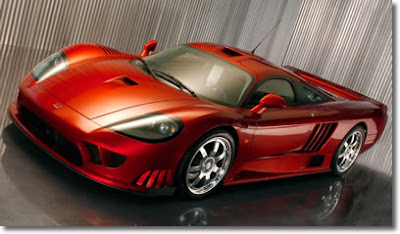
Saleen knows all about power. As in S281 Mustangs, N2O Focuses and the S7,

Saleen is not an organization content to rest on yesterday’s 0-60 mph times or quarter-mile speeds. So in 2005, it was “goodbye S7” and “all hail the S7 Twin Turbo!” This is the first major change to the S7 since its introduction, and it is a big change as in 750 horsepower and 700 lb-ft of torque, numbers the competition will be chasing for a long while we predict.
Unchanged From 2005
While there are a number of different roads Saleen’s engine designers could have traveled down to achieve those high-altitude horsepower and torque figures, for this second edition of the S7 they decided to think beyond atmospheric. And because this is Saleen, they added a double twist to a tried and true racing technique for boosting power and torque: twin turbos.
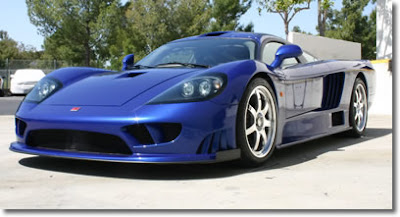
Aerodynamics has also come under scrutiny in 2005. Unless you place the new S7 Twin Turbo next to one of the original 2002 models, you probably won’t notice that the 2005 version has a different diffuser/rear spoiler package and reshaped front fenders to enhance the S7s already sleek, swoopy and aerodynamic contours. To complement the Twin Turbo’s enhanced straight-line performance envelope the S7 chassis has also undergone a fair amount of tweaking. Virtually every suspension pickup point has been changed, and the suspension geometry has been modified for less squat and dive during acceleration and braking.
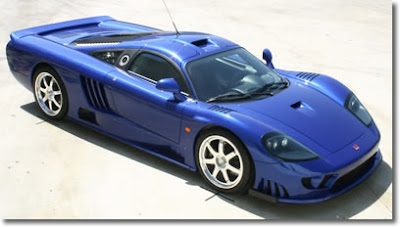
Engine & Drivetrain
Designed by Saleen engineers, the S7's engine and drivetrain incorporate the latest in modern racing technology. The new all-aluminum V8 engine casting was engineered and tooled by Saleen to displace seven liters. Redline is 6500 rpm. Space age materials and engineering are used throughout, including stainless steel valves, titanium retainers, beryllium exhaust valve seats, an aluminum throttle body, Saleen designed aluminum CNC-machined cylinder heads and stainless steel exhaust system. An exclusive
d to the twin ball bearing turbos, is pressurized to 5.5 psi max and then passes through an oval-bore throttle body into an aluminum intake manifold with eight individual runners.
To feed juice to this setup, the injection system includes dual electric fuel pumps and high-capacity, return-less, 52 lb/hr fuel injectors. Neatly engineered and integrated into the S7’s stainless steel, dual, high-flow exhaust system are two, twin-ball-bearing, water-cooled Saleen-Garrett turbos, featuring 44-mm wastegates. The four exhaust
pipes from each bank of cylinders merge into a race-car-like high-efficiency collector. In addition, the exhaust incorporates dual catalysts per cylinder bank, EGR and those aforementioned twin wastegates. And because Saleen believes in power and clean air, the emission control system features dual, heated oxygen sensors per cylinder bank and a high-volume evaporative emission system along with those four catalysts. Oh, and for good measure and clean air, the system is OBD-II compliant.
And if you need any more proof of how Saleen engineers sweat the details, the stroke of the already short-stroke shifter has been furthered shortened for improved shifting feel. Say that five times fast, once for each gear change.

Chassis, Suspension & Brakes
The S7 chassis and suspension incorporate decades of Saleen’s experience in racing, racecar construction and high-performance road car manufacturing. The Saleen S7 architecture begins with a space frame chassis to which honeycomb composite reinforcing is grafted. The body is structural, aerospace-quality, autoclave carbon fiber. Suspension is via fully independent unequal-length double wishbones with coilover springs, lightweight aluminum dampers (shock absorbers) and stabilizer (anti-roll) bars front and rear. The uprights at each corner are CNC machined billet aluminum, flow-through designs that use air to help cool the bearings.
Chassis tuning also includes revised shock valving front and rear. Saleen-engineered Brembo-supplied lightweight aluminum six-piston mono-block calipers are fitted front and rear.
Geometry changes, along with new tires, result in about a 30 percent increase in mechanical grip... which is substantial. In a seeming contradiction to current performance tire practice, the 2006 S7 Twin Turbo is fitted with “taller” tires, 275/35 R19s up front and 335/30 R20s at the rear, replacing the 275/30 R19s and 345/25 R20s fitted to the normally aspirated S7. While the Michelin Pilot Sport PS2 tires have higher aspect ratios, they also lay tire patches that are nearly an inch wider up front and almost 1.5 inches wider at the rear.
 Exterior & Interior
Exterior & Interior
The S7’s beautiful shape was “designed” by the wind. Optimal aerodynamics and top speed performance objectives were achieved with extensive wind tunnel work. Targets included a low coefficient of drag, optimum drag-to-lift ratio, and extreme down force. The S7 has “full tray” body sculpting underneath.
For the 2006 S7 Twin Turbo, the redesigned front and rear diffusers, along with the new rear spoiler, result in a 40 percent reduction in aero drag and a 60 percent increase in down force. Those of you who know anything about aero forces recognize the significance of that last statement. Typically, you would have to trade down force to reduce aero drag.
The mid-engine Saleen S7 has front and rear trunks and comes with Mulholland Brothers custom-made, 3-piece, fitted luggage. In true supercar style, the doors open up and away from the body.
 Seats and other interior surfaces are covered in elegant leather and suede. Air conditioning, power windows, power door locks with remote keyless opening for the doors and both trunks, an electric-headed front windshield, variable intermittent windshield wipers, a leather-wrapped steering wheel and an AM/FM/CD/DVD/TV system are all standard. The Saleen S7 also has one unique interior feature: a video “rearview mirror” — there is a small video camera inconspicuously mounted in the rear of the car.
Seats and other interior surfaces are covered in elegant leather and suede. Air conditioning, power windows, power door locks with remote keyless opening for the doors and both trunks, an electric-headed front windshield, variable intermittent windshield wipers, a leather-wrapped steering wheel and an AM/FM/CD/DVD/TV system are all standard. The Saleen S7 also has one unique interior feature: a video “rearview mirror” — there is a small video camera inconspicuously mounted in the rear of the car.
| Specifications | |||||||||||||||||||||||||||||||||||
Base Price: $585,000 | | ||||||||||||||||||||||||||||||||||
Source: RSportscars
2008 Porsche 911 GT2
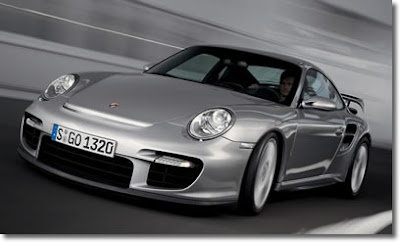
With a stunning 530 turbocharged horsepower and the most revolutionary design in the industry, Porsche revealed its most powerful production 911 ever on
New features such as large air intakes at the front and the rear wing, coupled with the rear-wheel drive and manual six-speed gearbox, express the elite performance abilities that are exclusive to this outstanding model. This high-performance athlete accelerates to 60 mph in just 3.6 seconds and reaches a top track speed of 204 mph.

530-Horsepower Twin-Turbo Engine
The power unit of the new 911 GT2 is based on the six-cylinder boxer engine of the 911 Turbo, with air supply driven by two exhaust gas turbochargers featuring variable turbine geometry (VTG). The 3.6-litre boxer engine achieves a maximum output of 530 (SAE) horsepower, an increase of 50 horsepower from the previous 911 GT2. The power increase is provided by two turbochargers with a larger compressor wheel and a flow-optimized turbine housing raising turbocharger pressure to an even higher level.
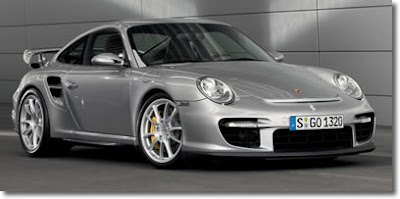
Decreased Fuel Consumption
The new 911 GT2's expansion intake manifold, which uses oscillating air in the intake during the cooler expansion phase, keeps the temperature of the fuel/air mixture even lower than in the 911 Turbo. This results in a significant increase in all-round efficiency, with fuel consumption down by up to 15 percent under full load despite the increase in engine output. This is a genuine innovation for turbocharged power units.

Functional Design Features
A number of elements set the new 911 GT2 apart including the new achievements in emission management and control. This is the first Porsche homologated for the road to feature a muffler and tailpipes made of titanium as standard equipment. This expensive material reduces weight by approximately 50 percent vs. a comparable component made of stainless steel.
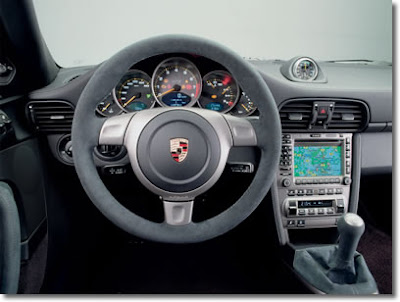
The new 911 GT2 comes as standard with PCCB brakes featuring brake discs made of a composite carbon fiber/ceramic compound ensuring highly consistent and maximum stopping power. Also standard is the electronically controlled Porsche Active Suspension Management (PASM) system.
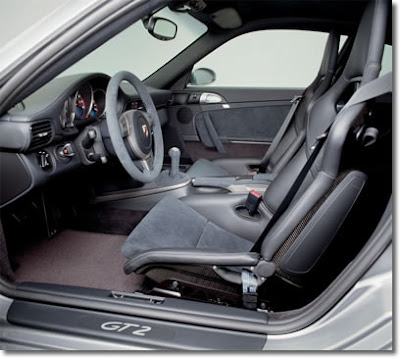 The GT2 comes on 19-inch light-alloy wheels filled with 235/35 ZR19 front sport tires and 325/30 ZR19 rear sport tires. It is scheduled to make its North American debut in early 2008 at a
The GT2 comes on 19-inch light-alloy wheels filled with 235/35 ZR19 front sport tires and 325/30 ZR19 rear sport tires. It is scheduled to make its North American debut in early 2008 at a
| Specifications | |||||||||||||||||||||||||||||||||||
Base Price: $191,700 / 189,496 € | | ||||||||||||||||||||||||||||||||||
Source: RSportscars
2009 Mitsubishi Lancer Ralliart
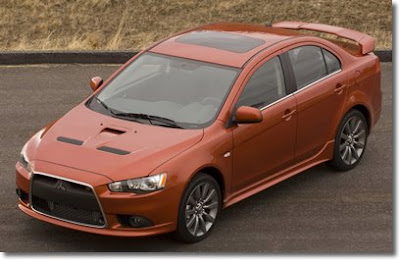
Filling a performance hole left between the ho-hum 2009 Mitsubishi Lancer and the scorching 2009 Lancer Evolution, the Mitsubishi Lancer Ralliart offers desirable specs in the performance department at a price that fills the sweet spot in Mitsubishi’s lineup and poses the AWD small sports sedan as a direct competitor to the new 2009 Subaru WRX.
The Lancer Ralliart’s engine has quite a pedigree, being the same basic 2.0 liter block and head used in the Lancer Evolution, though detuned, with less boost, for application in the Ralliart. An interesting inclusion at this price point is Mitsubishi’s TC-SST transmission, a paddle shifted, dual clutch sequential manual.
The styling is more Lancer Evolution than Lancer throwaway econobox, and manages to maintain the snarling look of the Evo while staying subdued enough to appeal to compact sports car fans who may be turned off by oversize hood scoops and picnic table rear spoilers.
This is not to say that the Lancer Ralliart is conservative in any way. Think of it as the Lancer Evolution on a diet: plenty of performance, chiseled and eye-catching design, and a price and driving dynamics that anyone can appreciate.
| Specifications | |||||||||||||||||||||||||||||||||||||||||
Base Price: $27,000 | | ||||||||||||||||||||||||||||||||||||||||


[From Mitsubishi Press Release]
The new Lancer Ralliart reinforces the sporty identity of the Lancer lineup (Lancer, Lancer Ralliart and Lancer Evolution) with aggressive styling and driving performance that creates a unique product between the Lancer GTS 2.4 and the Lancer Evolution models. The Lancer Ralliart makes effective use of the Lancer's rigid unibody and four-wheel independent suspension by mating this capable chassis to a turbocharged engine and all-wheel-drive.
 Mechanical
Mechanical
Lancer Ralliart is powered by the new 4B11 2.0-liter DOHC MIVEC intercooled and turbocharged engine (also used in the Lancer Evolution) that develops an estimated 235 horsepower. The engine is mated to Mitsubishi's efficient Twin Clutch-SST gearbox that helps enhance the sporty nature of the vehicle by allowing the driver to execute lightning-quick, silky-smooth, paddle-actuated shifts. The TC-SST transmission also operates in fully automatic modes for
The Lancer Ralliart's full-time 4WD driveline features Mitsubishi's Active Center Differential (ACD). The ACD unit employs an electronically controlled multi-plate clutch center differential, vectoring drive torque to the front and rear according to different driving conditions to realize the best balance between steering response and traction characteristics on Tarmac, Gravel, or Snow surfaces. Lancer Ralliart is also equipped with front helical limited slip differential and a rear differential mechanical limited slip differential.
Design
Elaborating on the basic sporty design and proportions of the Lancer, the Lancer Ralliart exterior is distinguished by its more aggressively styled front bumper design, rear bumper cover, dual outlet muffler and a lightweight aluminum, ducted hood that delivers cooling air to the turbocharger.
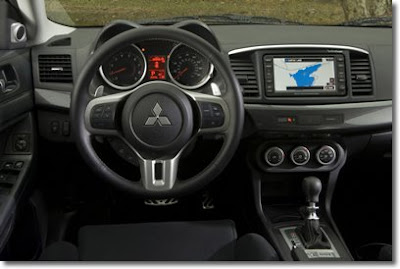
The interior design places greater emphasis on function and vehicle control. Lancer Ralliart is equipped with FAST key, Bluetooth® hands-free telephone interface, the same Twin Clutch-SST shifter used on Lancer Evolution, and easily accessible steering column mounted paddle shifters.
Available equipment and options to include: Recaro seats, HID headlights, 650-watt Rockford Fosgate 9-speaker audio system, Sirius satellite radio, power sunroof, and a 30-gigabyte hard drive navigation system with digital music server.
Source: RSportscars
2007 Toyota FT-HS Concept
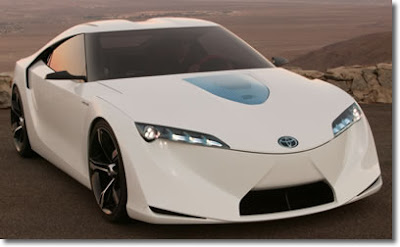
Pairing a potent hybrid powertrain with essential sports car fundamentals, the FT-HS concept was a joint undertaking of Calty,
"Drivers today are not satisfied with cars that are simply fast," said Kevin Hunter, vice president, Calty Design Research. "In addition to driving enjoyment, today's drivers are concerned about safety, ecology and social responsibility."
The FT-HS incorporates hybrid capability while maintaining sports car essentials, such as a sleek profile, lightweight aero-dynamic materials, and an advanced high-output powertrain for revolutionary acceleration and optimal performance. This 21st century sports car is fun-to-drive with eco-friendly benefits such as ultra-low emissions and fuel efficiency. The FT-HS appeals to an emerging buyer who grew up eco-conscious and per
ceives technology as a necessity, not a luxury.
This two-plus-two concept is a front-engine, rear-drive sports car with a projected zero-to-60 acceleration in the four-second range. A powerful V6, 3.5L-engine is coupled with a 21st century sports hybrid system with a target power output of approximately 400-horsepower. At a mid-priced market position, FT-HS would be a true "attainable exotic" with 21st Century performance.
FT-HS expresses the core values of a Toyota Brand design strategy that combines two key elements: J-Factor and Vibrant Clarity. J-Factor refers to the local and global acceptance of Japanese-inspired design and cultural sensibilities. Vibrant Clarity is the design language used to express the J-factor much in the same way that L-Finesse is the language of the Lexus Division. It is the combination of perfect imbalance, freeform geometrics and integrated component architecture. The result of these three elements is subtractive mass, a minimalist style that is not only lightweight, but also looks lightweight.
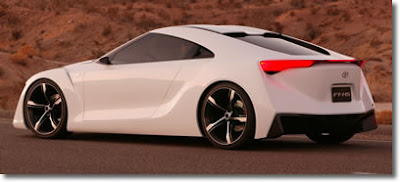
The exterior design was led by Calty designer, Alex Shen. From a design perspective, the theme of the FT-HS achieves sleek, taut surfaces in its exterior features – especially in the doors and body style. The front and rear have been sculpted to remove mass around key functional components. Freeform geometrics define the integration of fluid surfaces contrasting hard-edge "Aero-Corners" which promote smooth airflow and reduce turbulence.
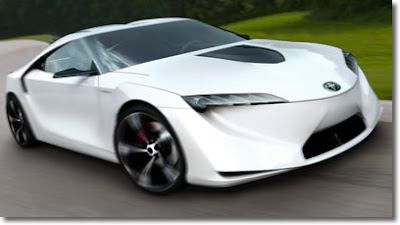
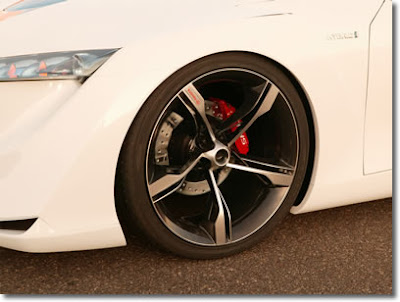
The roof has a distinctive scooped-out section designed to reduce aerodynamic drag and provide head room at the key areas. Made from carbon fiber Kevlar, the roof retracts so that the roof panel and back window pivot fluidly in a downward motion to stow in the rear seat space.
The vehicle's triangular profile has a floating "C" pillar, aero corners, a full upper-body pan, and innovative open top. A hood features a scalloped channel, exposing the hybrid engine. Integrated component architecture can be seen in the aeros
pace-inspired lighting. The tail lamp unit spans the entire rear, and has an integrated retractable spoiler. Light-emitting diode (LED) clusters are located in the headlamps and the wing for energy-efficiency and decreased heat loss. Other exterior features include a speed-activated wing that elevates at high speed for additional stability and traction. The rear showcases a carbon fiber lower diffuser with integrated wide exhaust and carbon fiber wheels.

The driver-oriented interior was created by Calty designer, William Chergosky and exudes sleekness, technology, and performance. The lean skeletal look is achieved with exposed cross-car architecture and high-tech materials such as carbon fiber, and titanium. FT-HS' interior features create a dedicated driver's cockpit which include subtractive mass expressions such as cross-car instrument panel structure and delta wing driver pod. The delta-wing driver's pod integrates many useful functions into a lightweight structural unit. All of the important functions and details are presented almost exclusively to the driver. For example, touch-trace sensors which surround the driver and act as tactile guides for fing
er controls when traveling at high speeds.
By eliminating the "B" pillar and creating a suspended "C" pillar, the minimalist style works in conjunction with subtractive mass. An integrated instrument panel surrounds the driver, creating an enclosed pod effect. Armrests flow seamlessly into the door and surrounding interior.
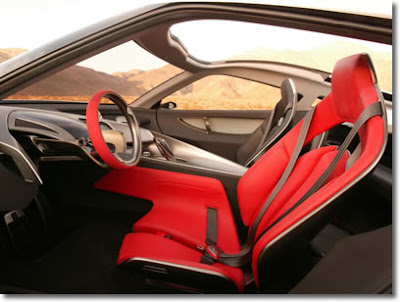 Seating is optimized for a lightweight appearance and function: the seating accommodates four and then coverts to a two-seater when the roof retracts. The passenger-seat area is open with a simple exposed airbag on the cross-car beam.
Seating is optimized for a lightweight appearance and function: the seating accommodates four and then coverts to a two-seater when the roof retracts. The passenger-seat area is open with a simple exposed airbag on the cross-car beam.
A telescoping hub-less steering wheel incorporates semi-automatic paddle shifters and allows the meter to be shifted forward in order to shorten the driver's focus-time between the road and meter, and ultimately enhance driver focus.
“FT-HS redefines the sports car experience not only with styling but also in function and performance,” said Hunter. “The FT-HS is
2009 Mercedes-Benz-SLK-Class-(SLK280,-SLK350)

Mercedes-Benz first launched its SLK roadster in 1997. A second-generation version was revealed for 2004, and a modest facelift to that model was introduced for 2008.
SLK -- which means Sportlich (sporty), Leicht (light) and Kurz (short) -- is positioned below the considerably more expensive SL roadster. The SLK was actually Mercedes' first hardtop convertible roadster, predating the SL hardtop.
The SLK competes with the BMW Z4, Audi TT, Infiniti G37, and Lexus SC 430. The only non-AMG SLK model offered in North America is the SLK 350, which is powered by a 305 horsepower 3.5L V6.
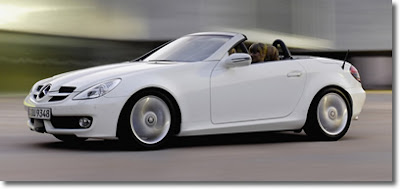
The 2004 redesign brought the introduction of a Formula One-inspired appearance and significant performance improvements. The 2008 update builds on this with a revised front fascia with more design cues